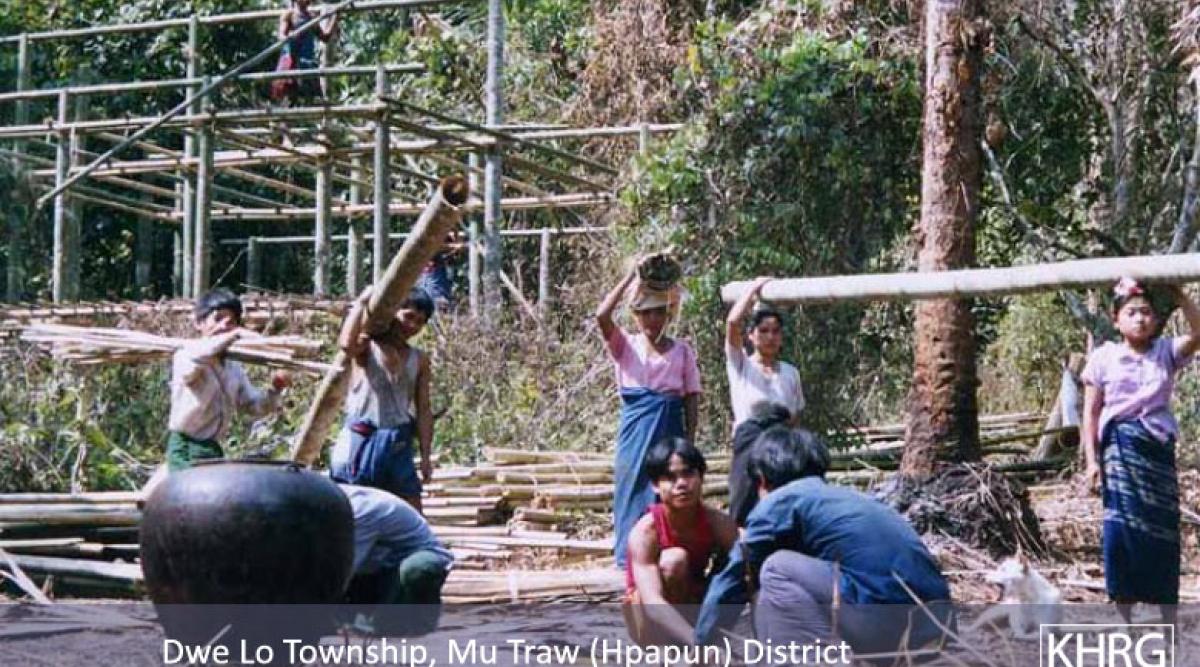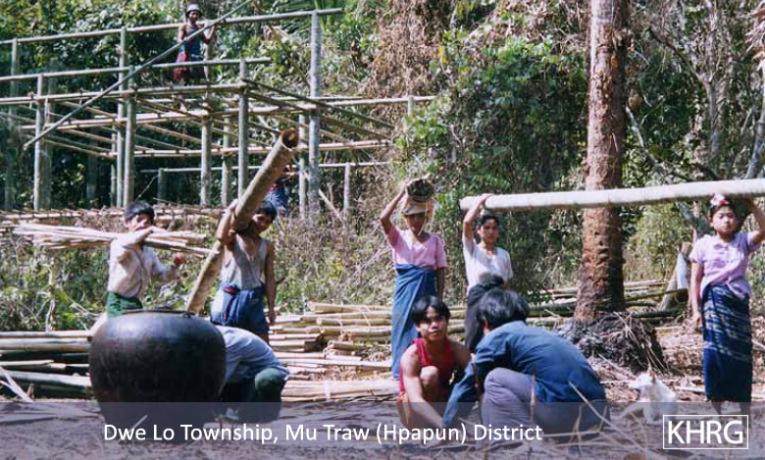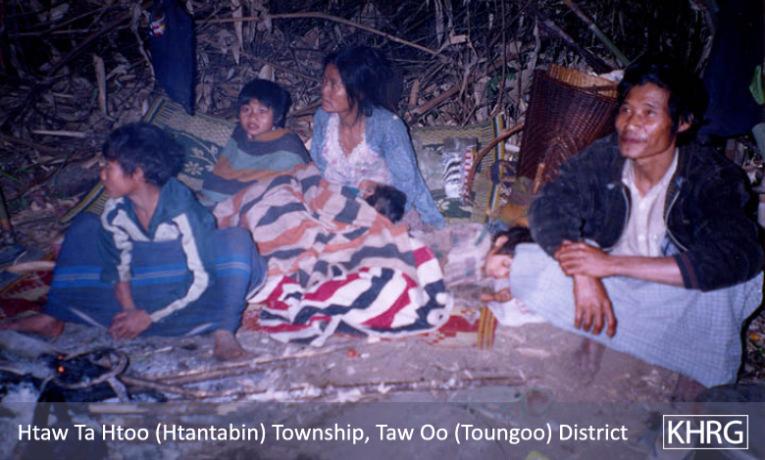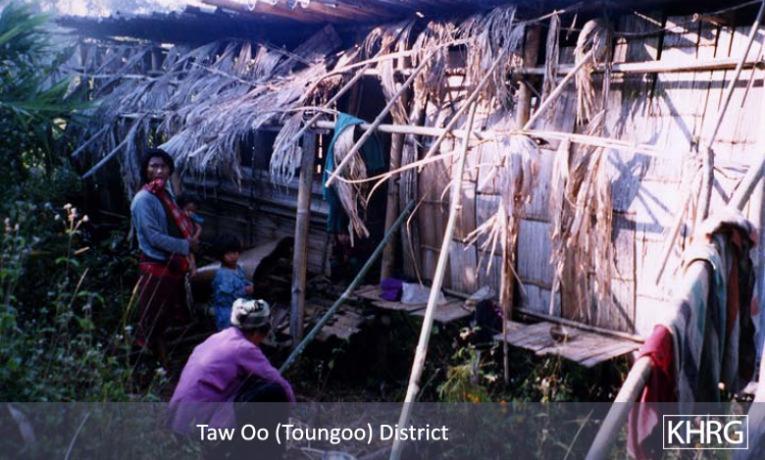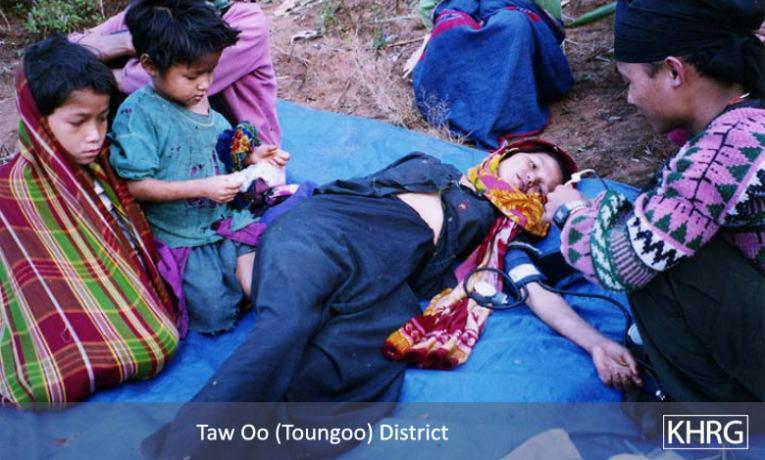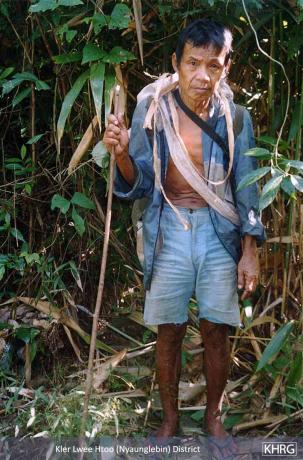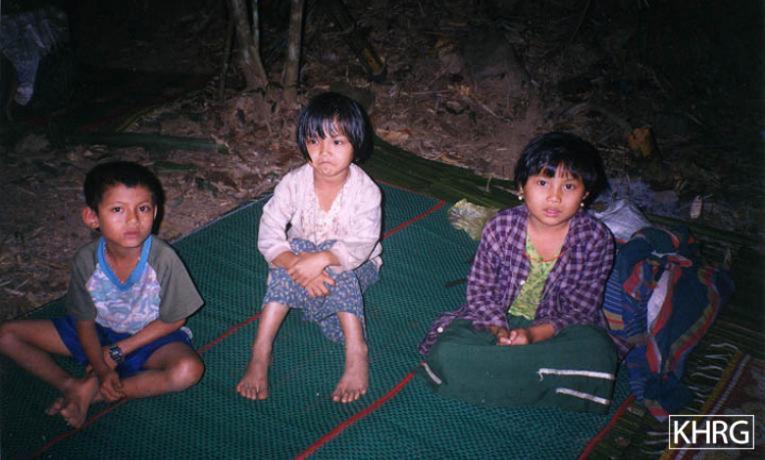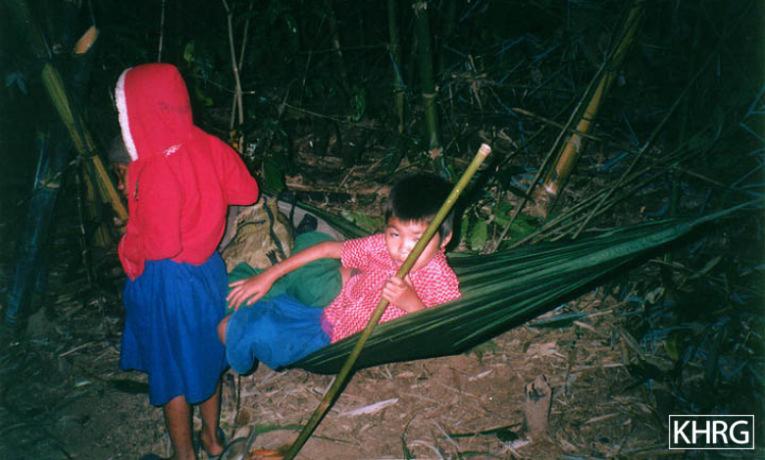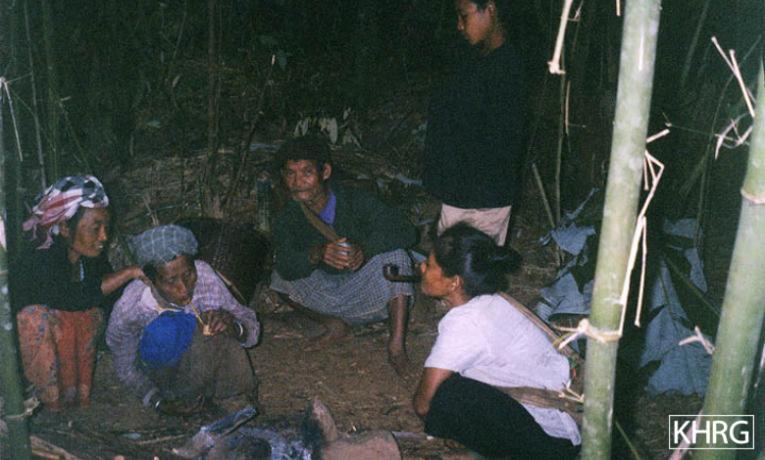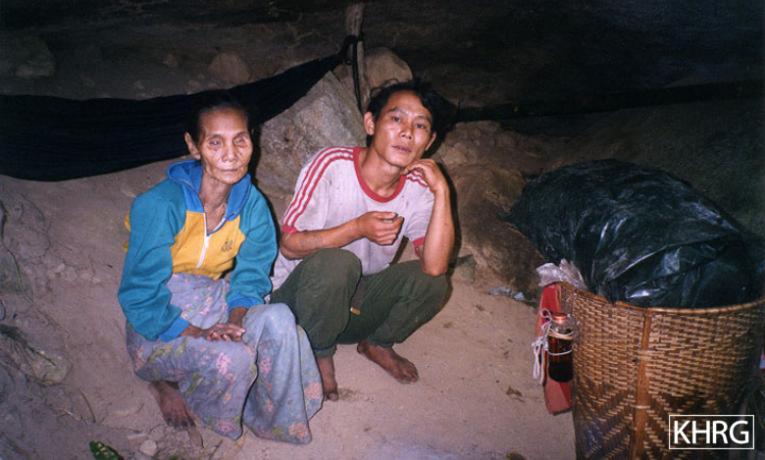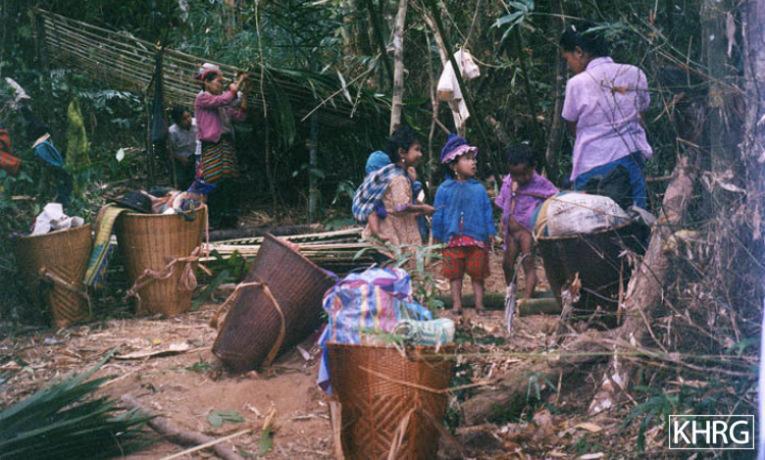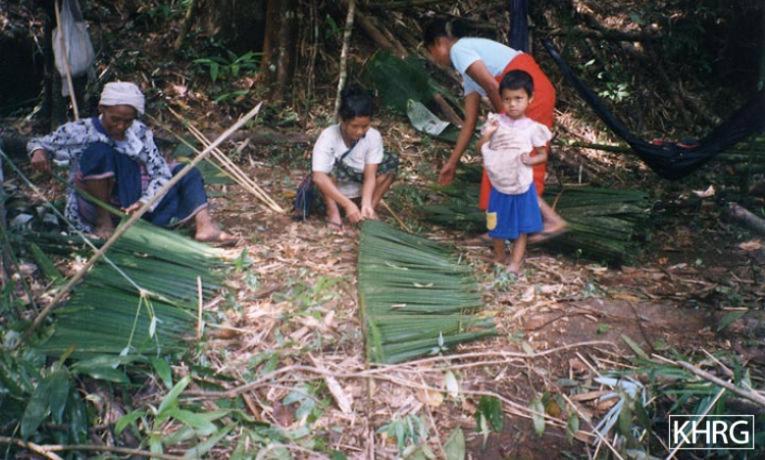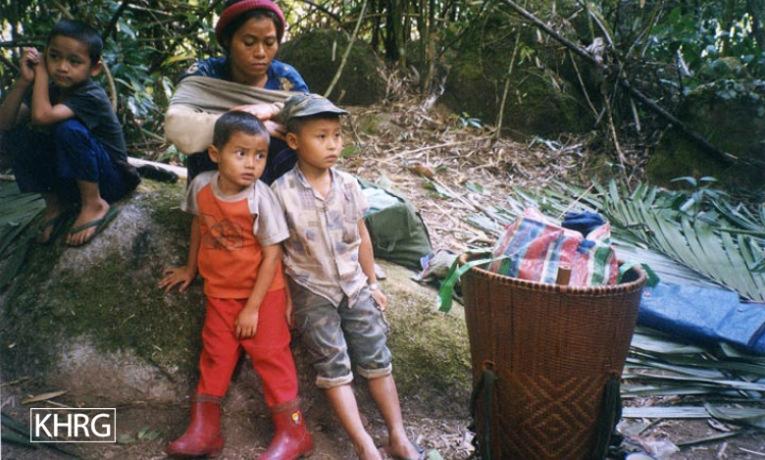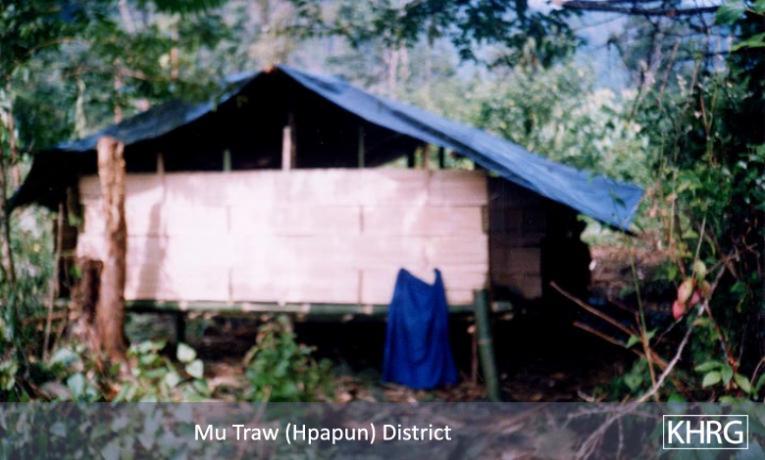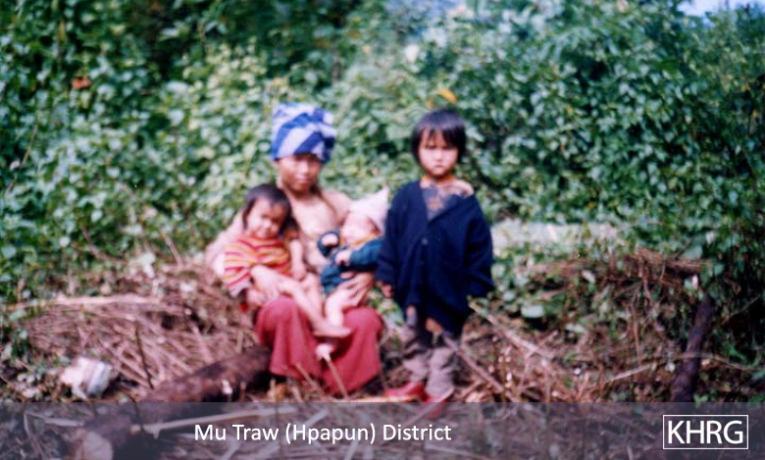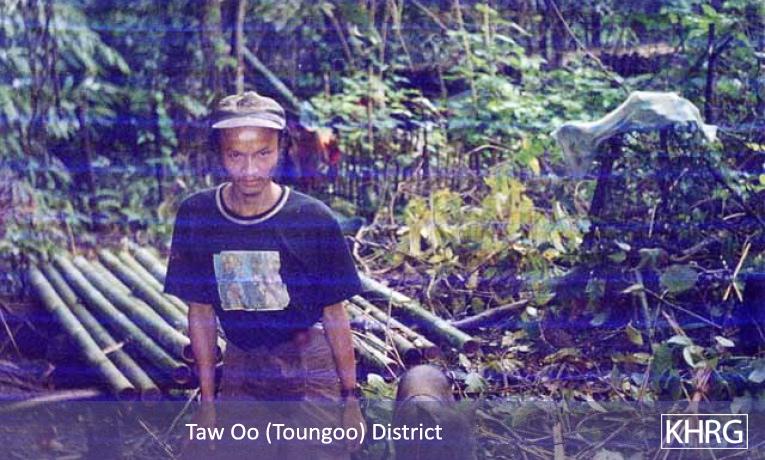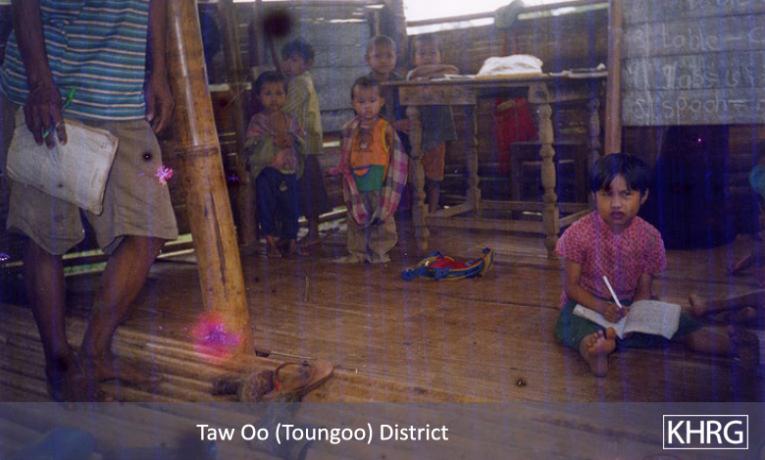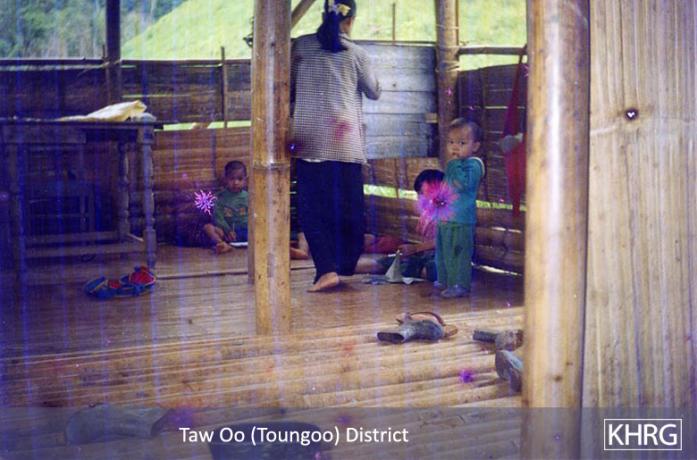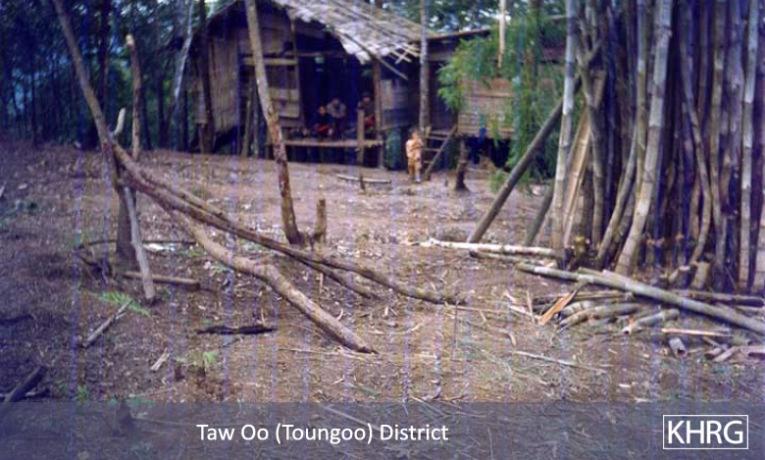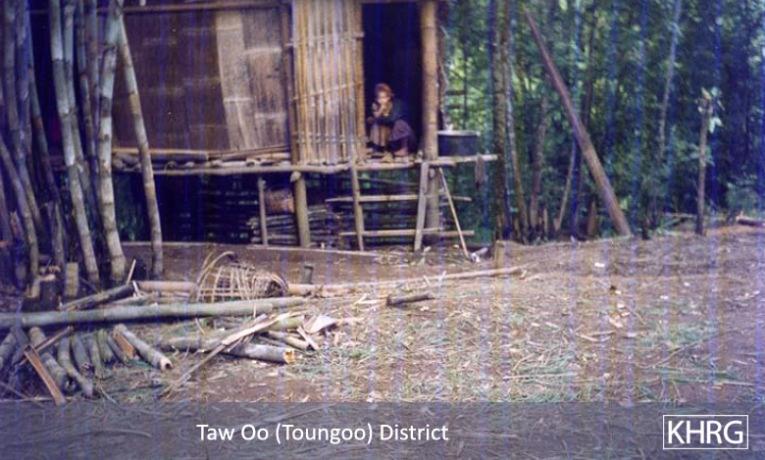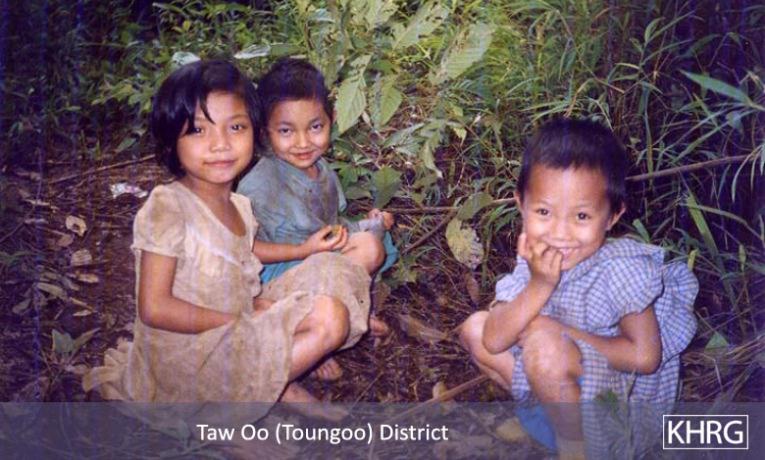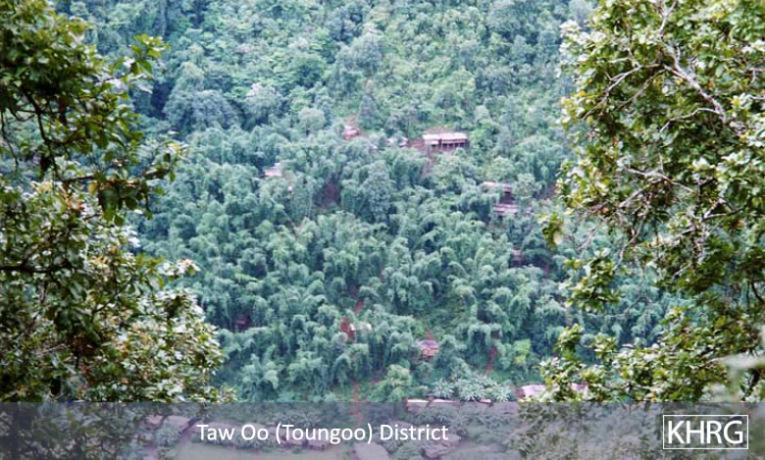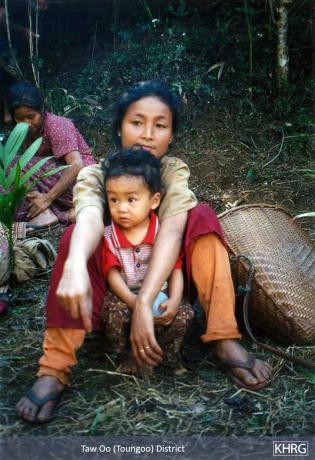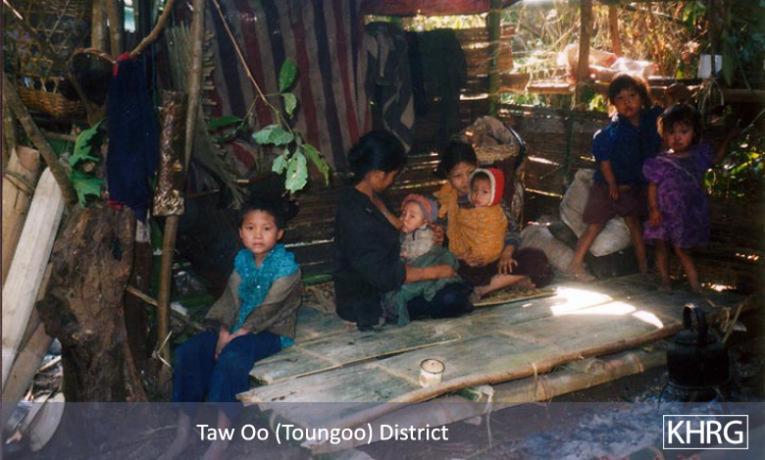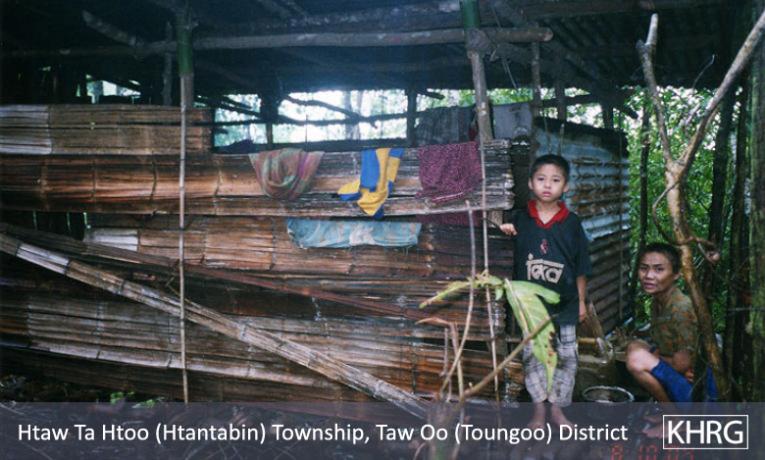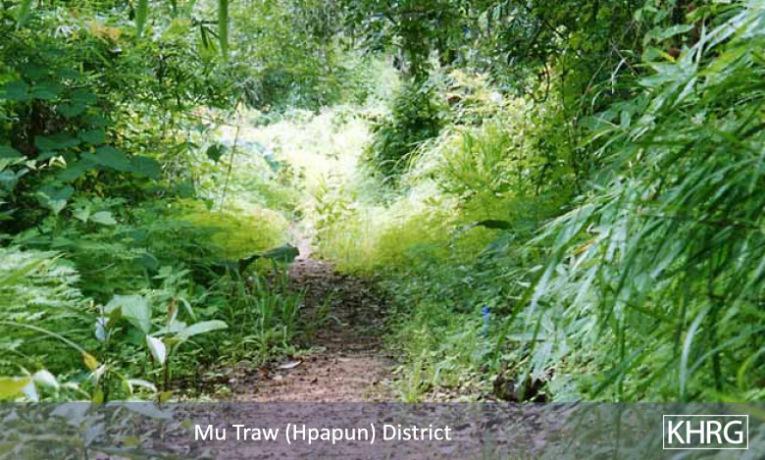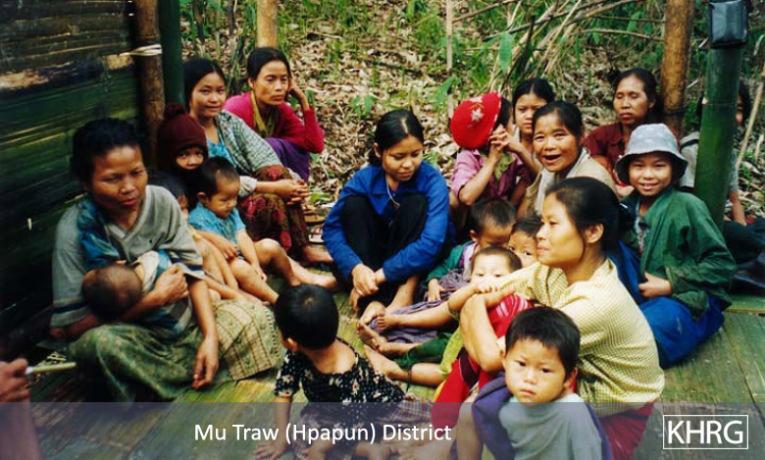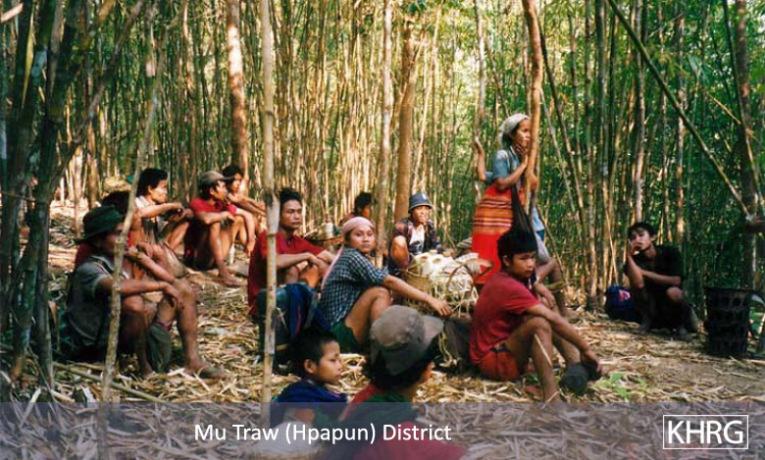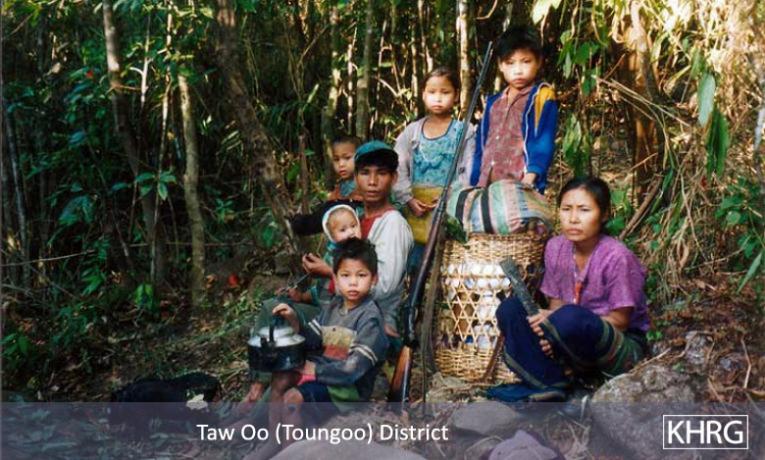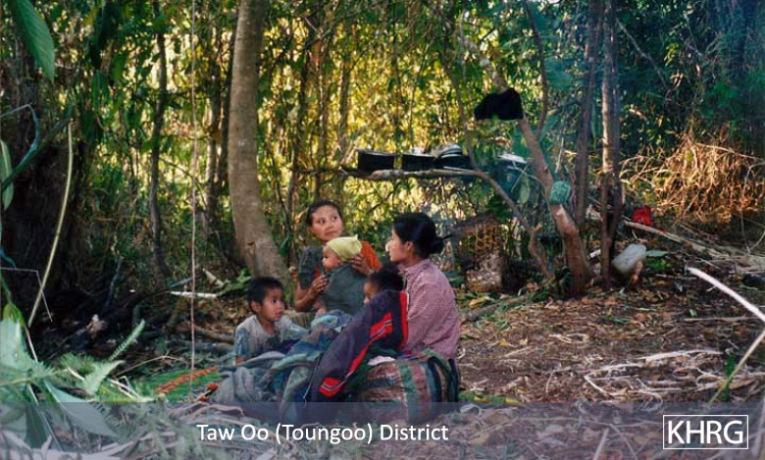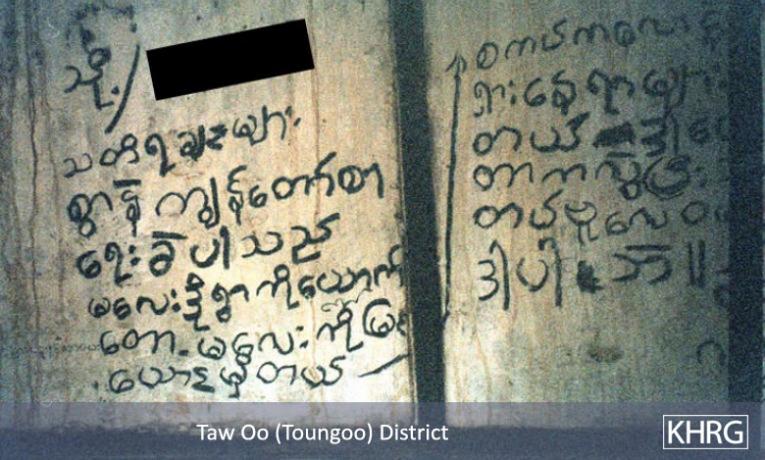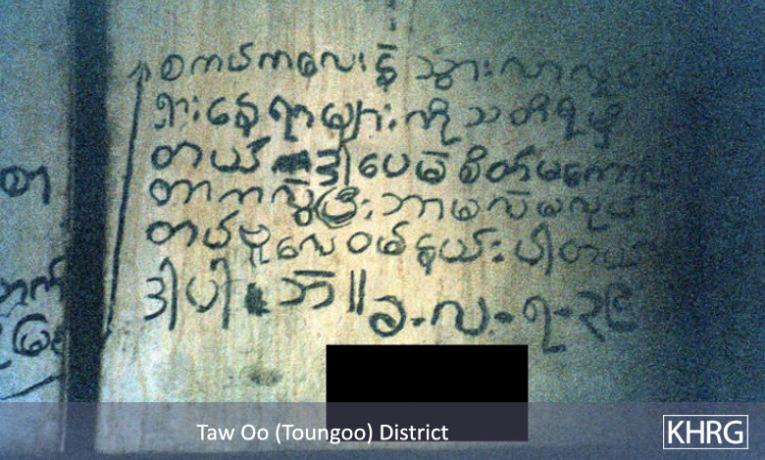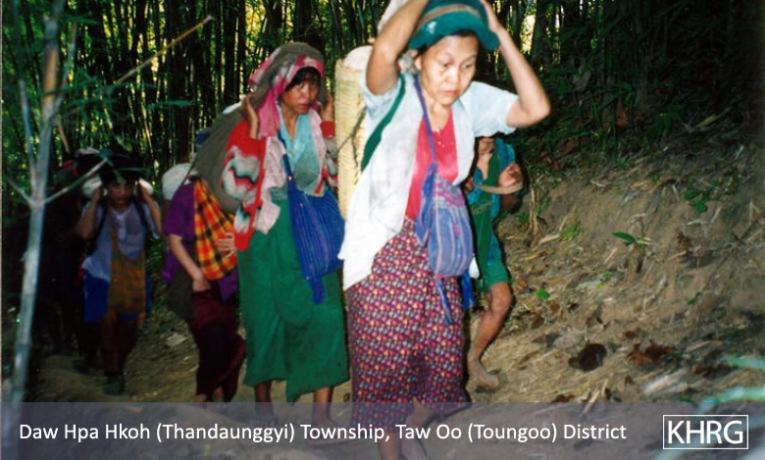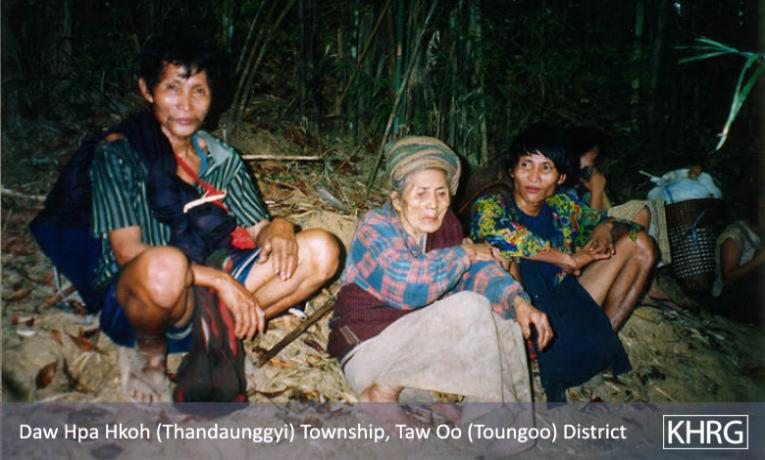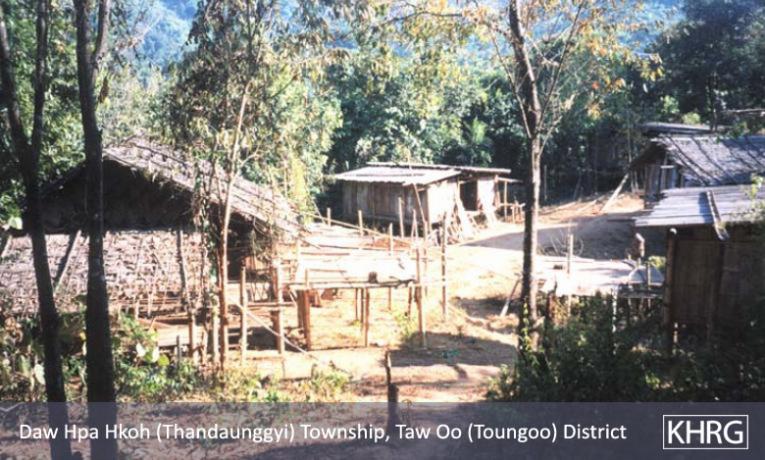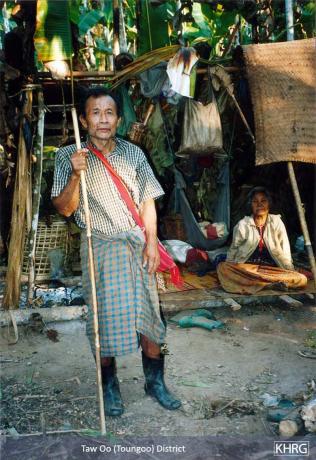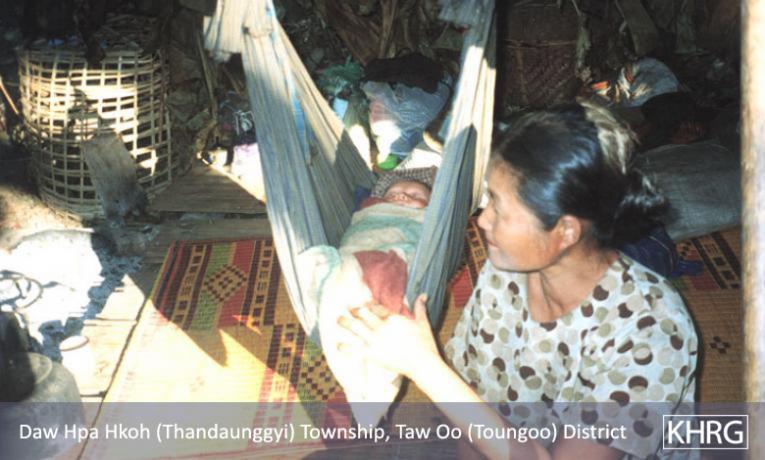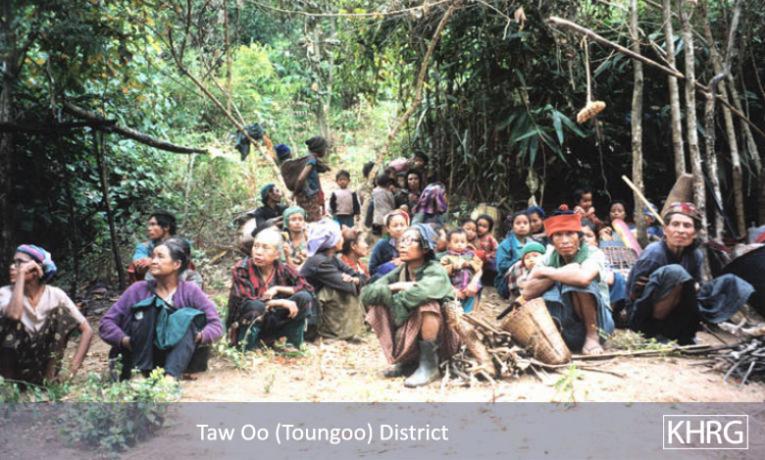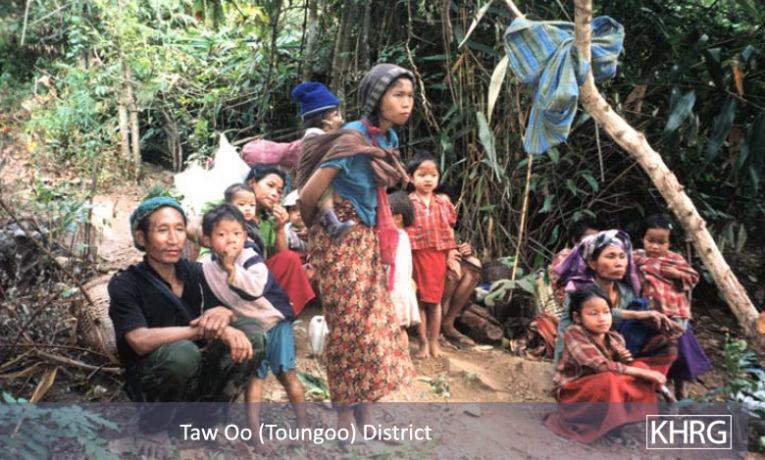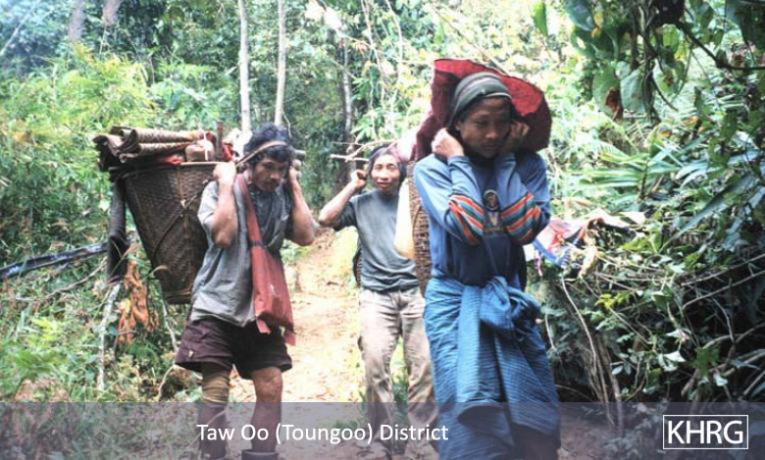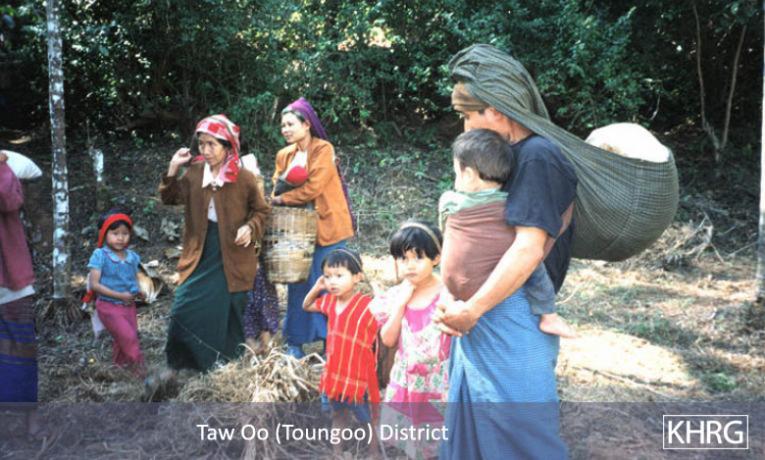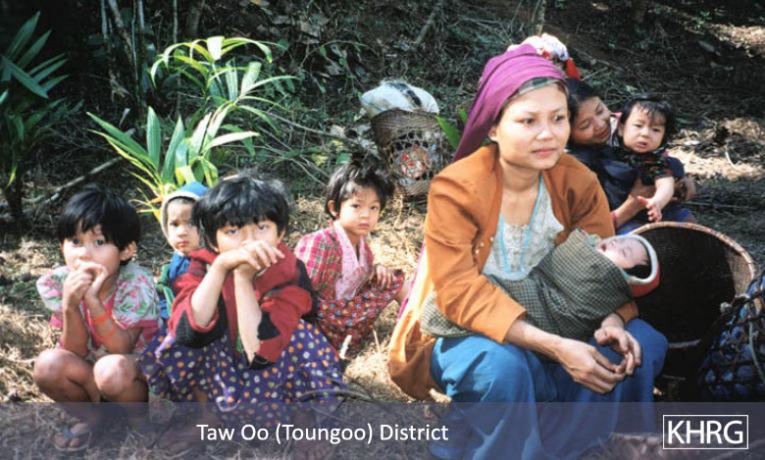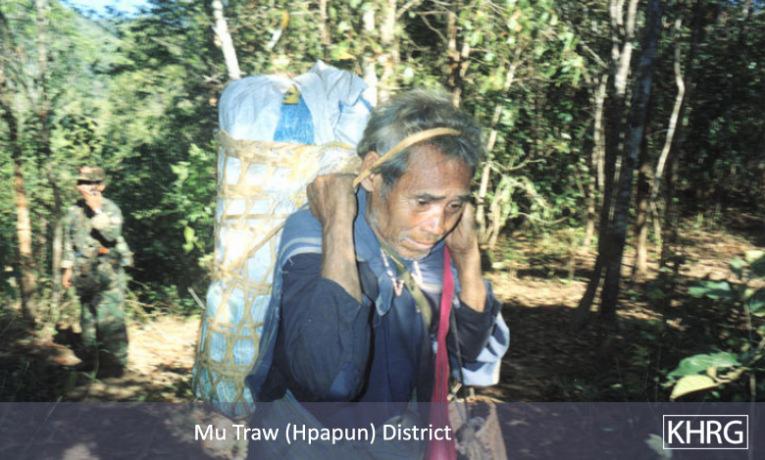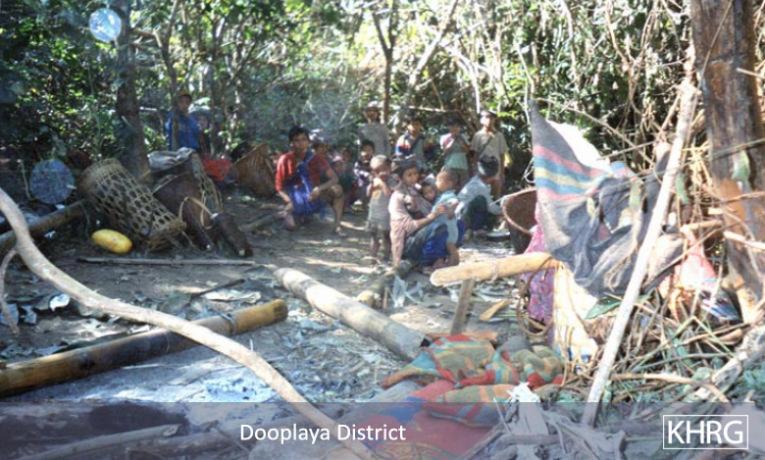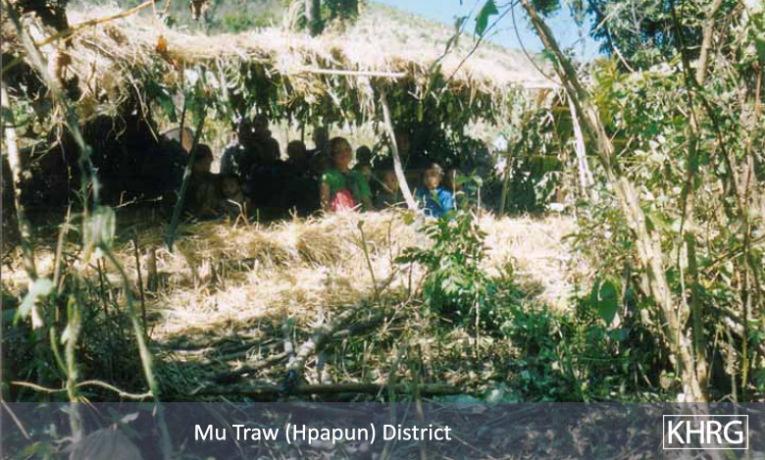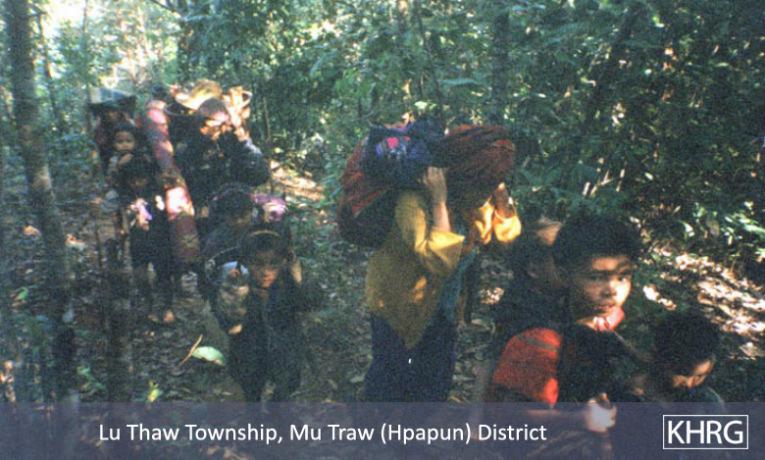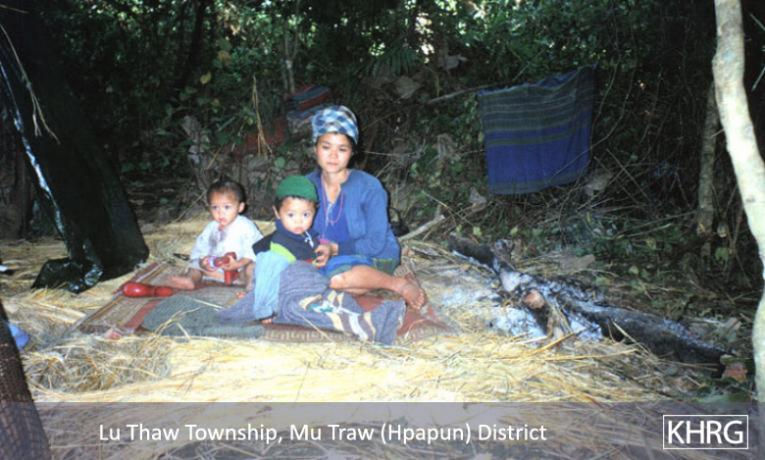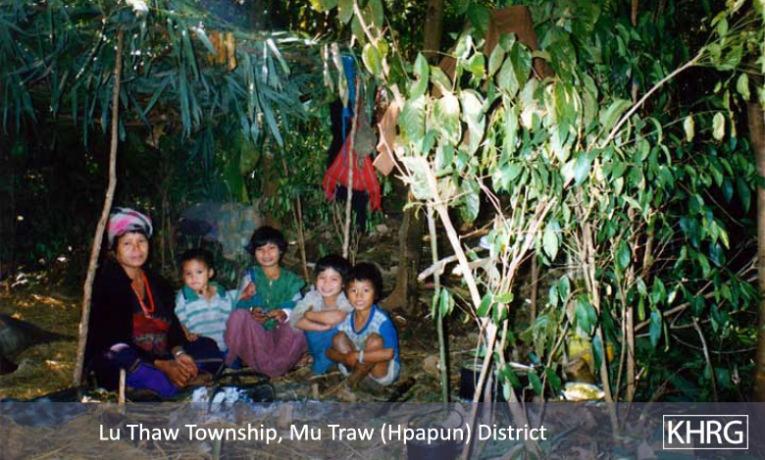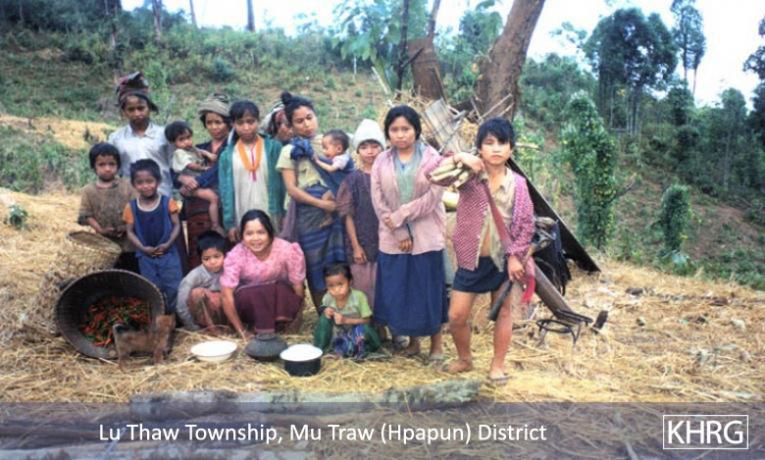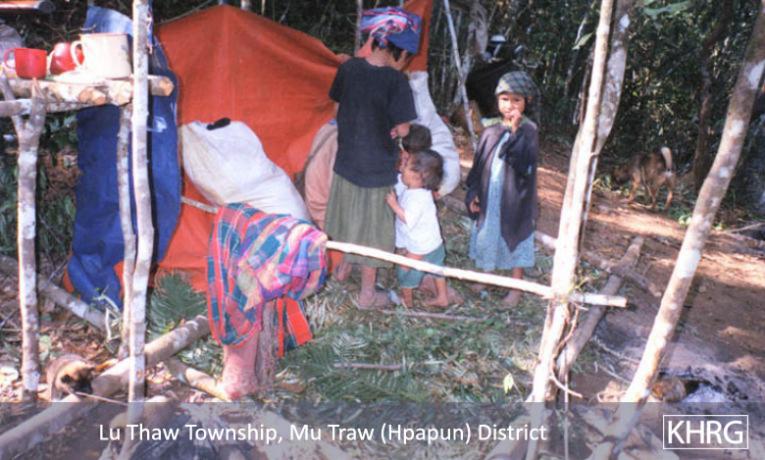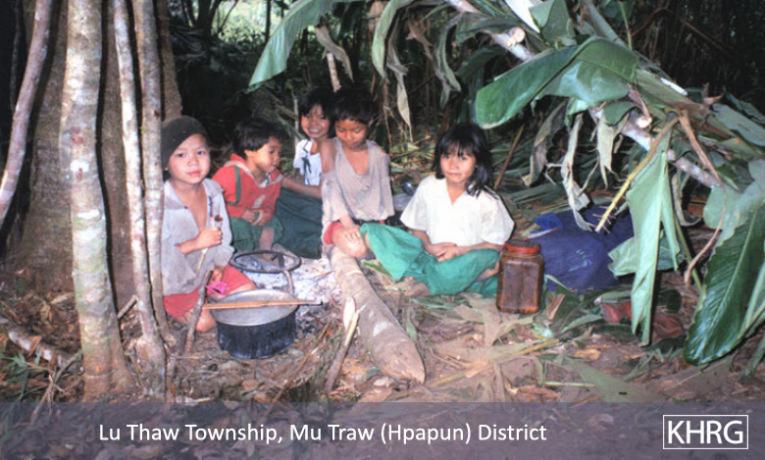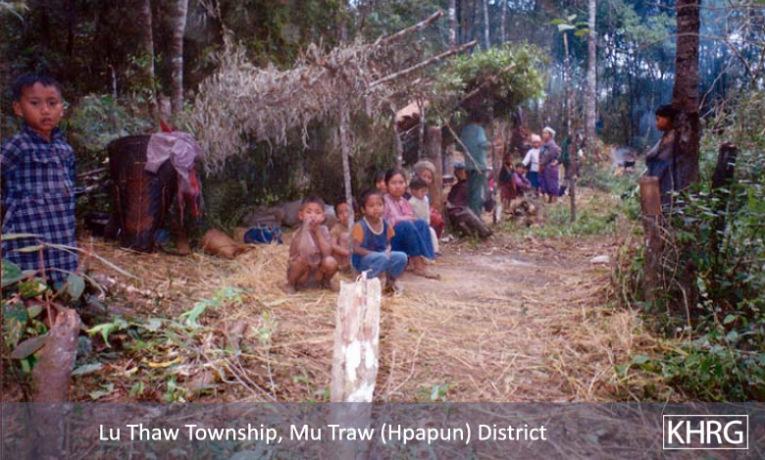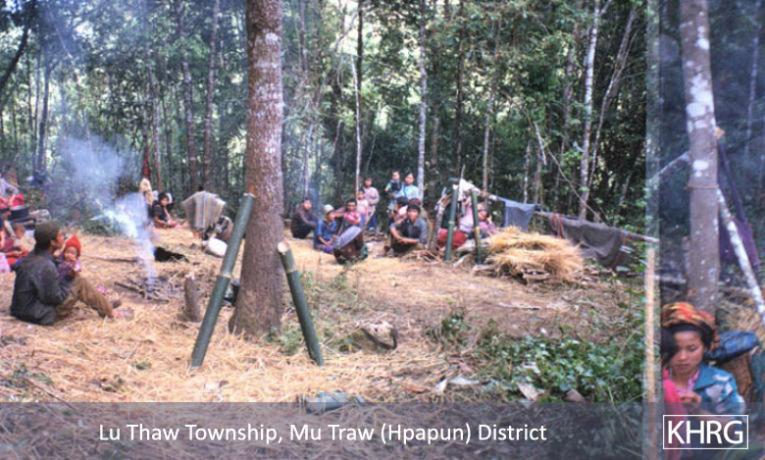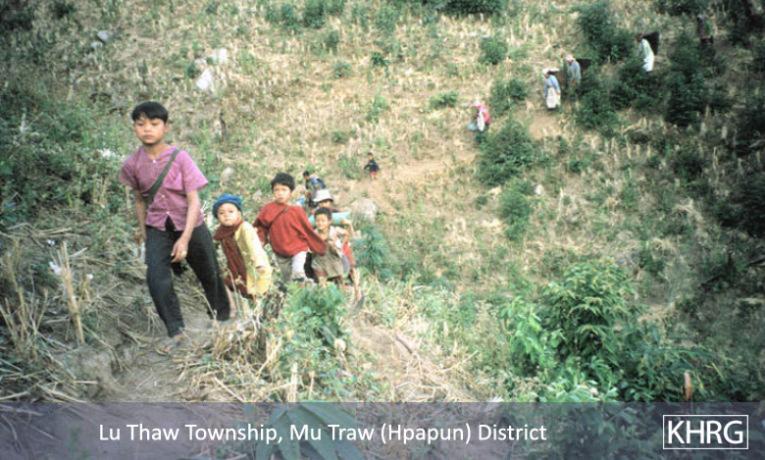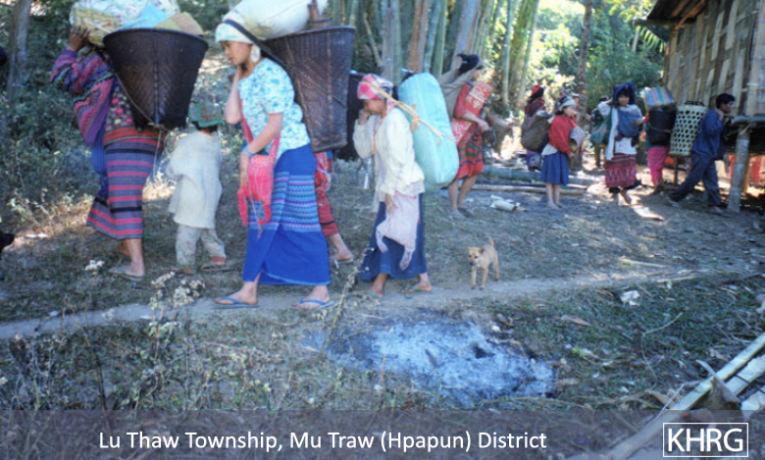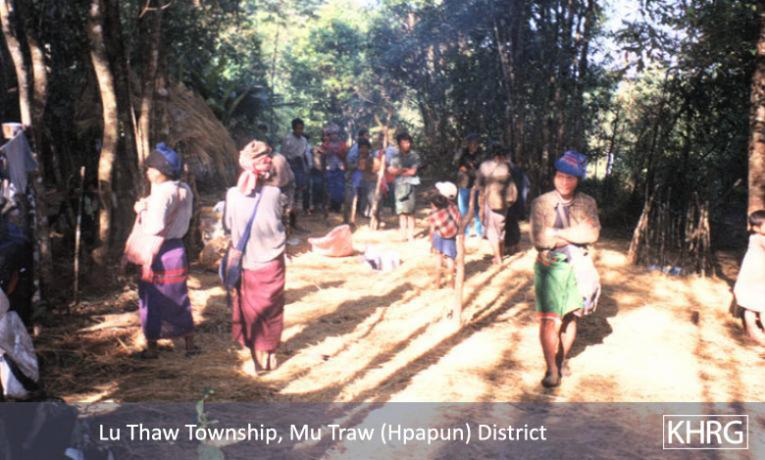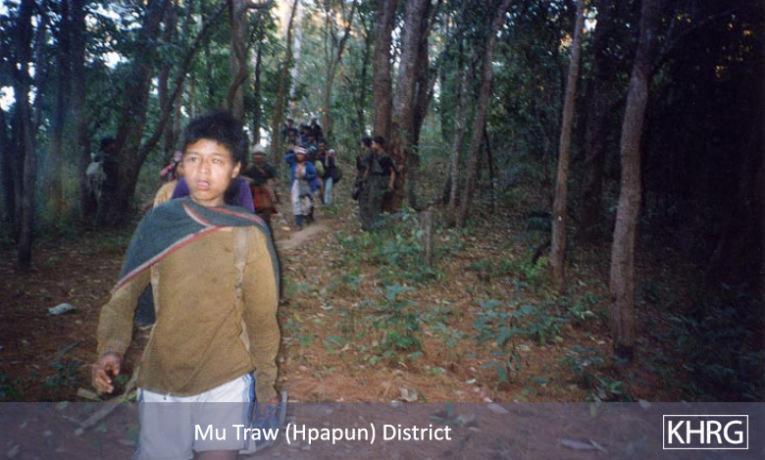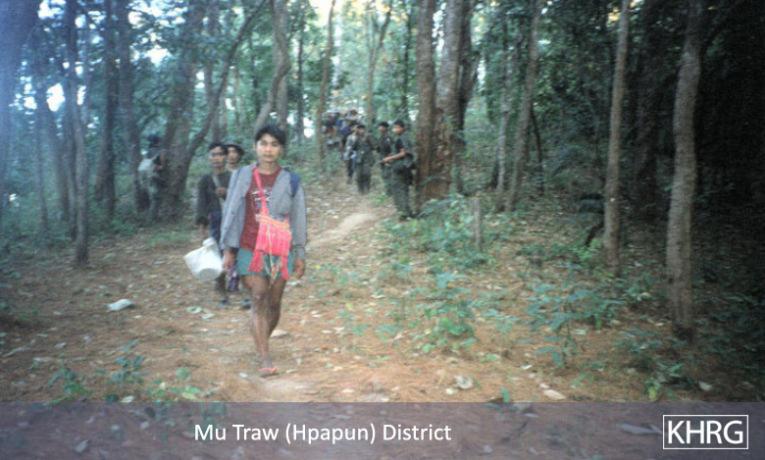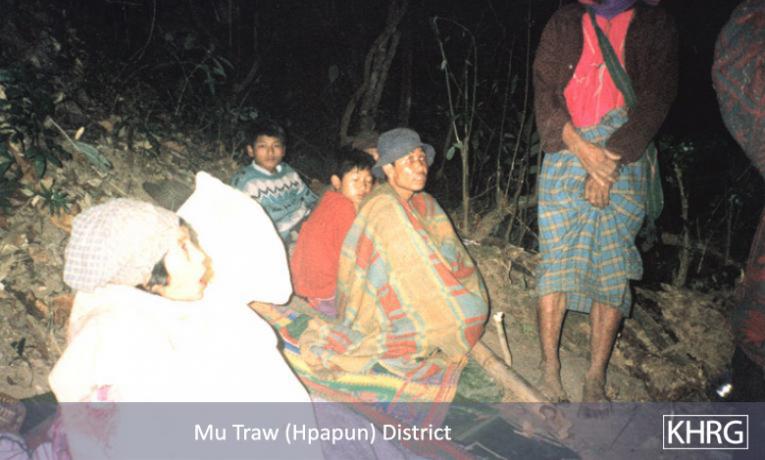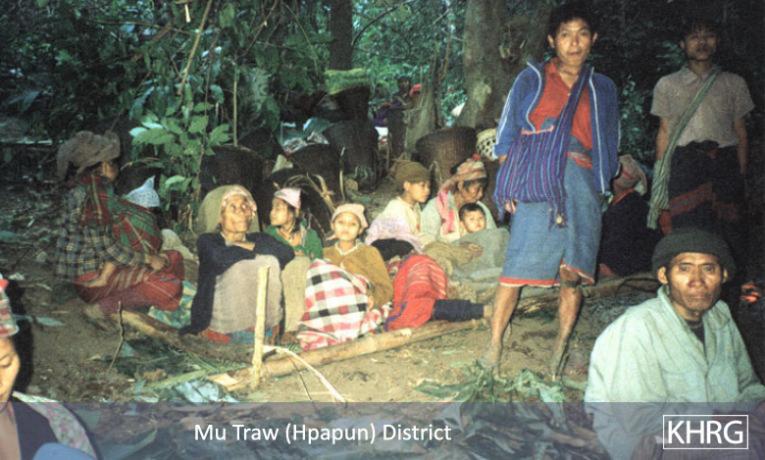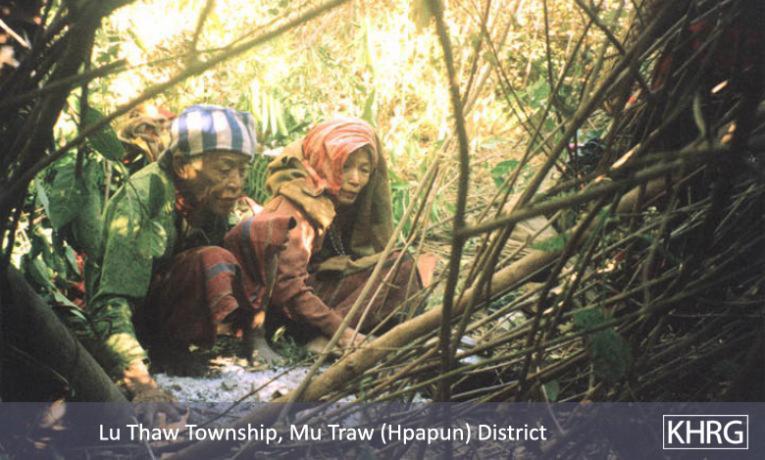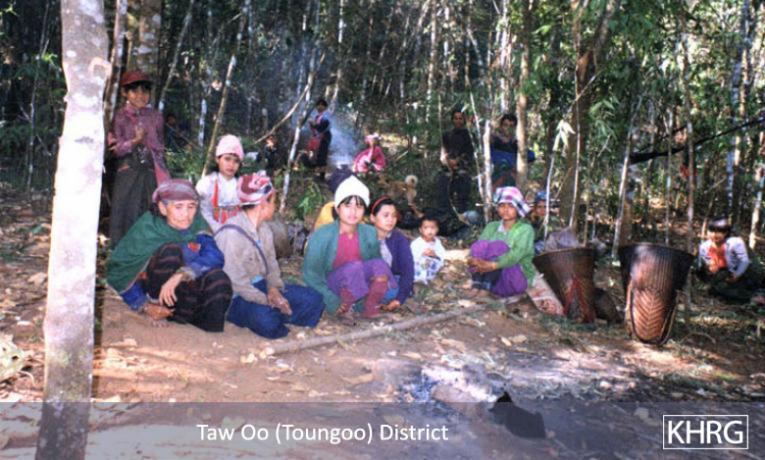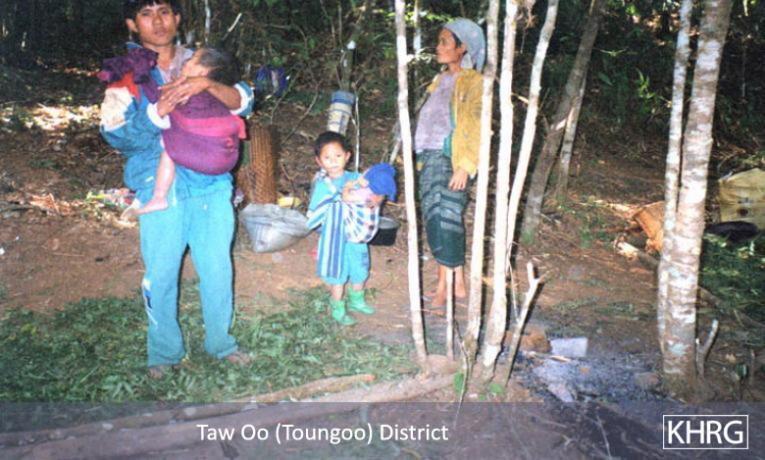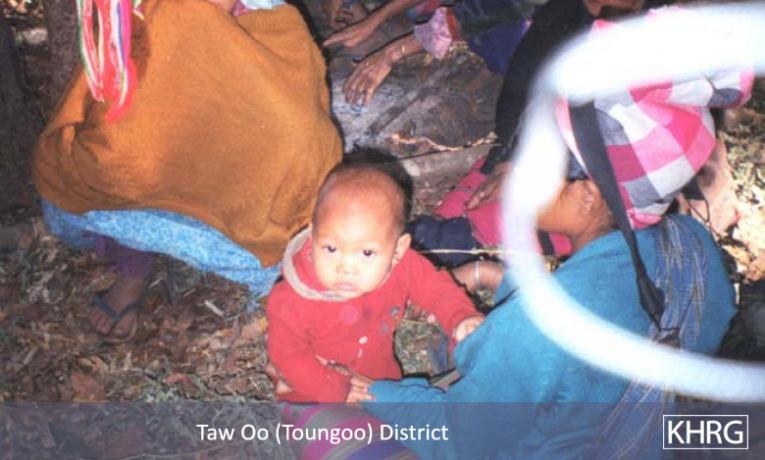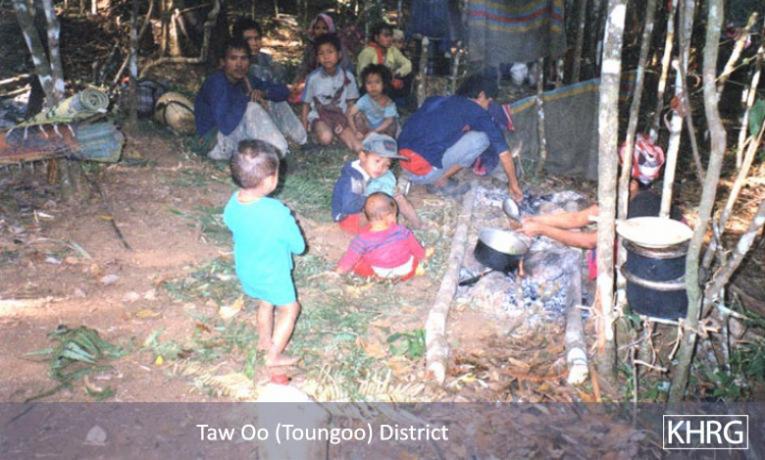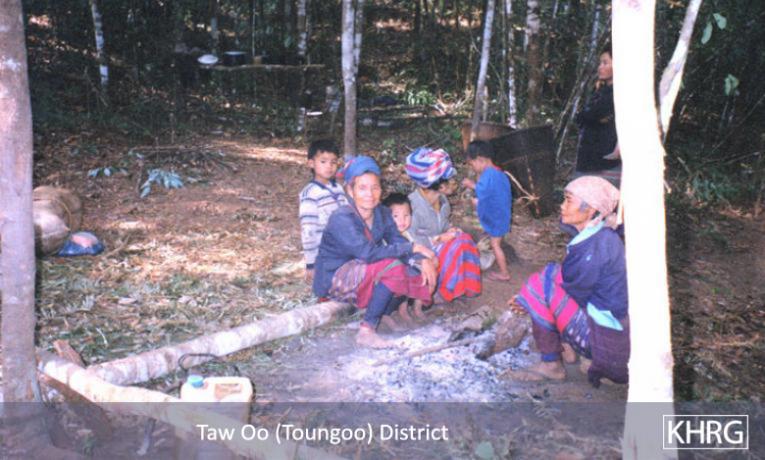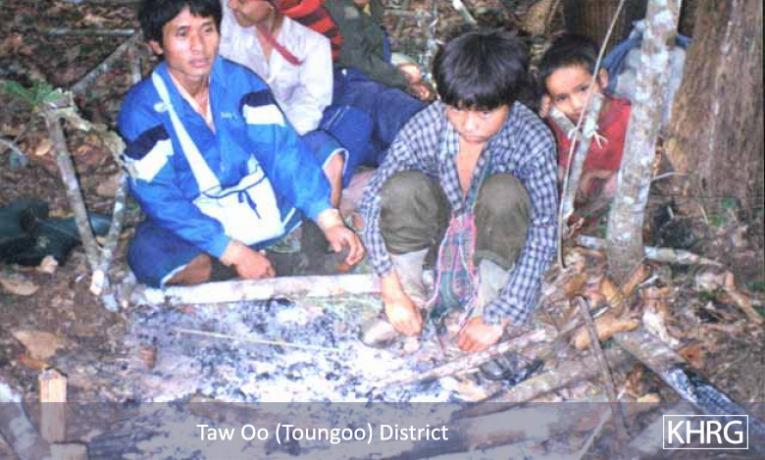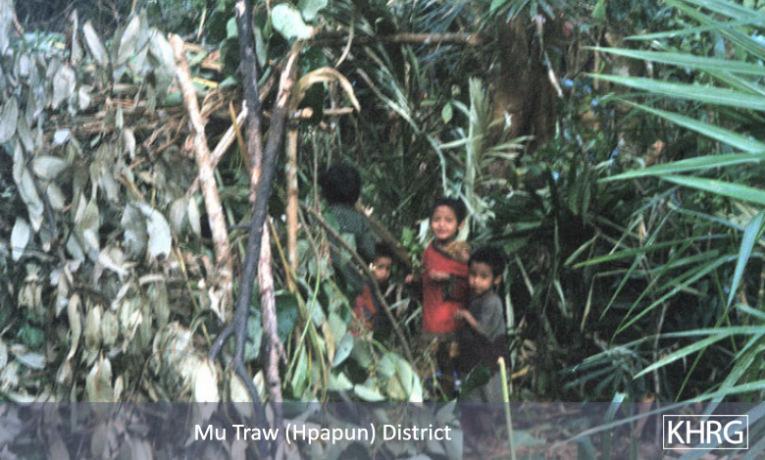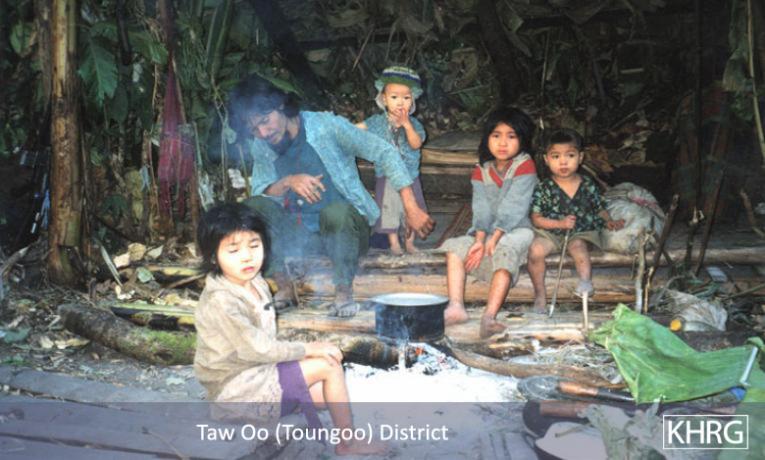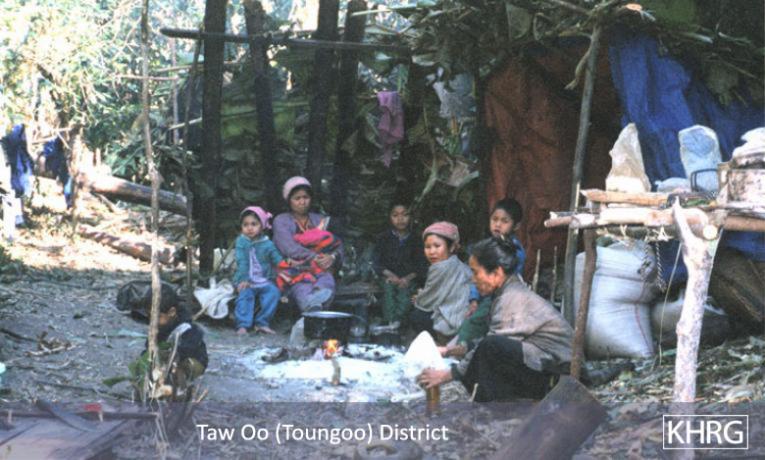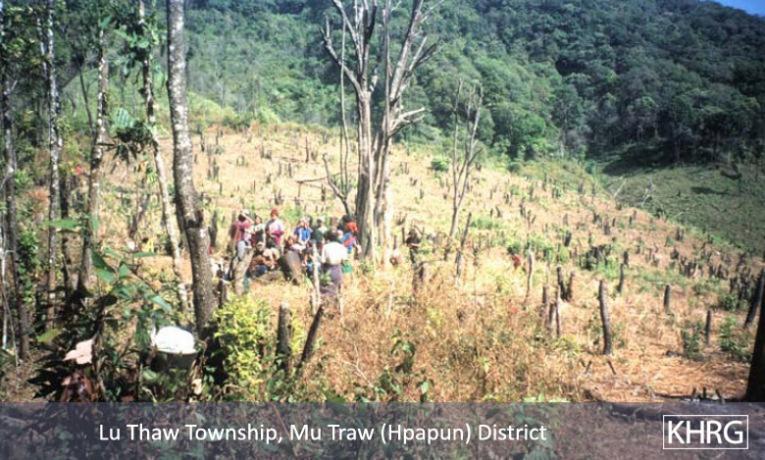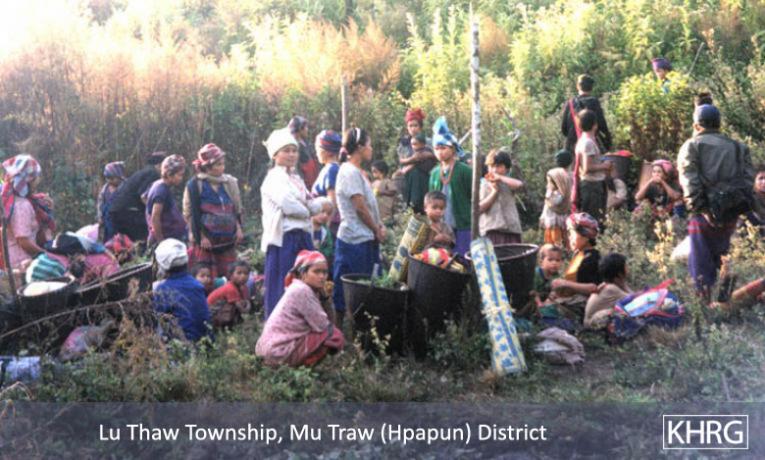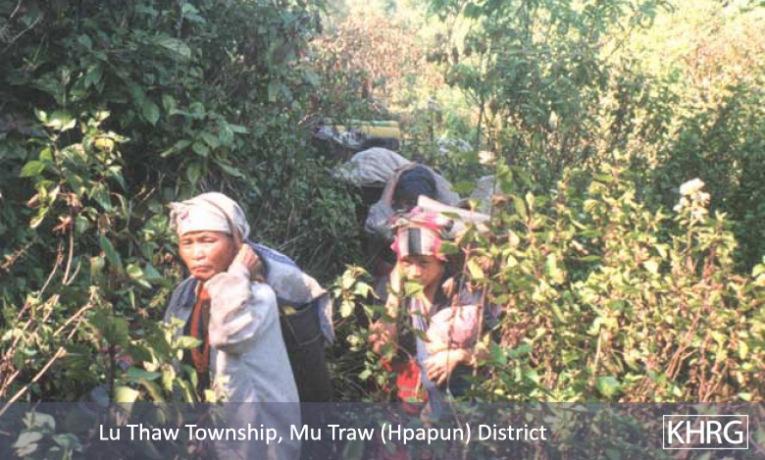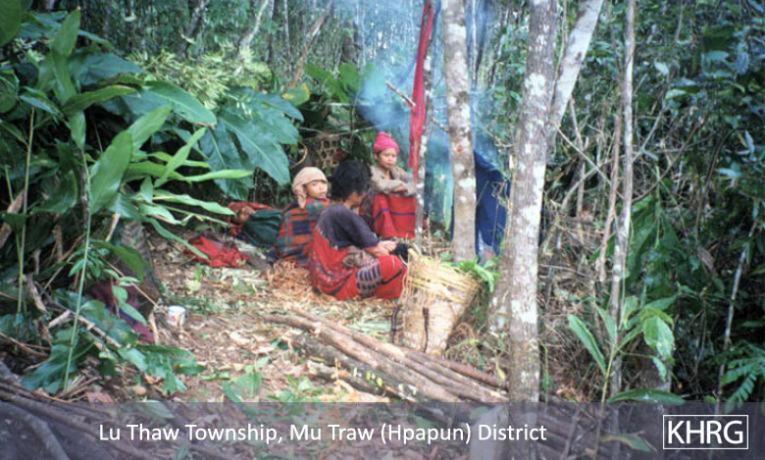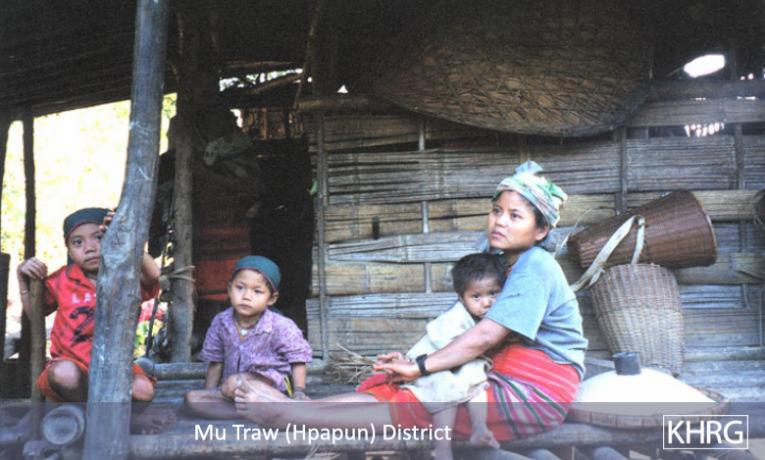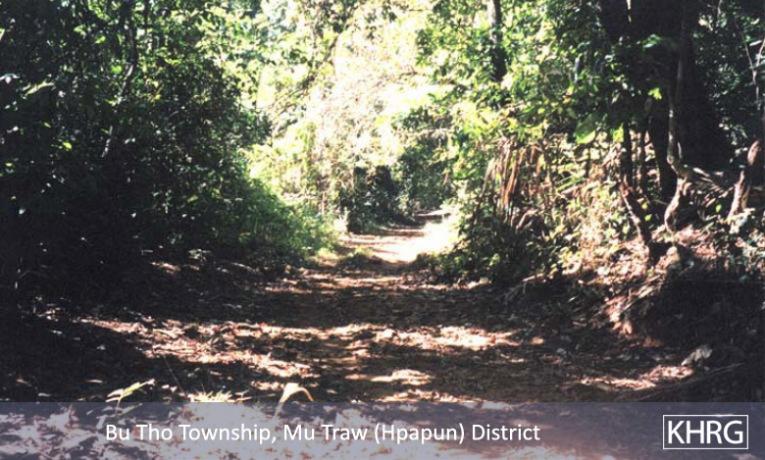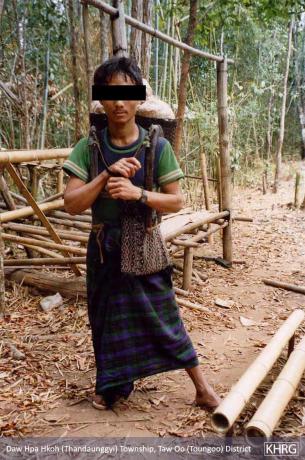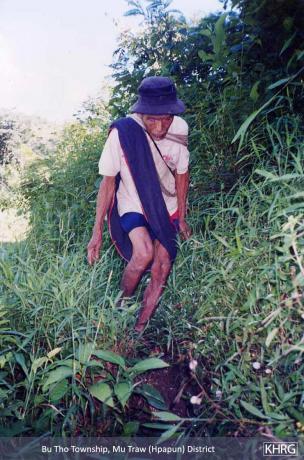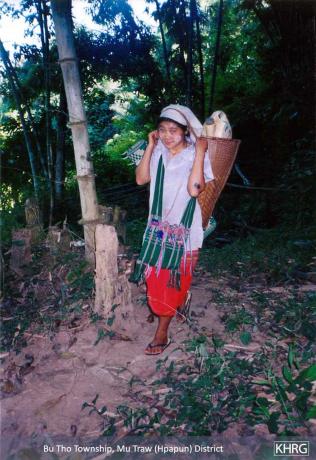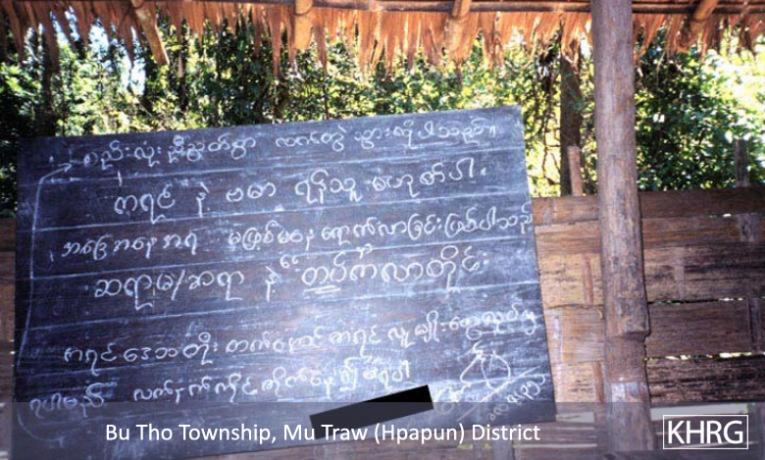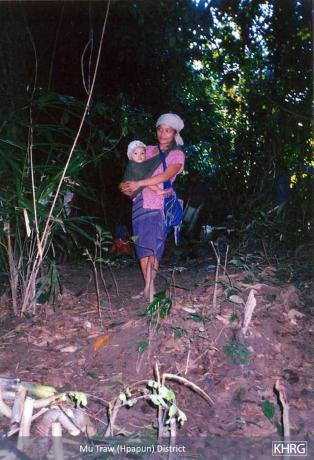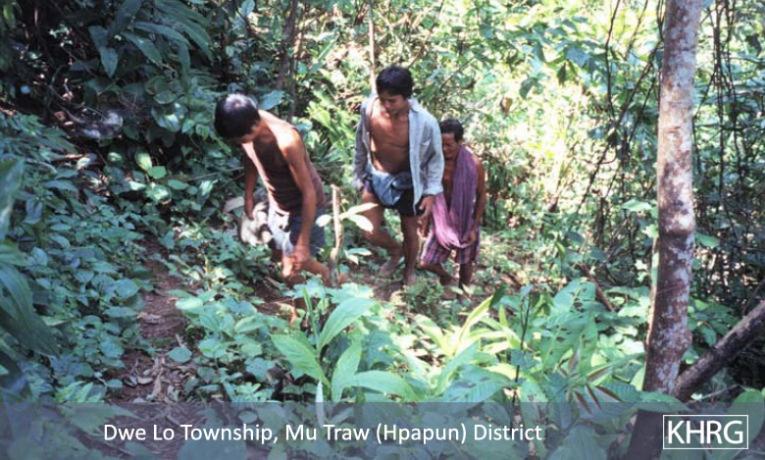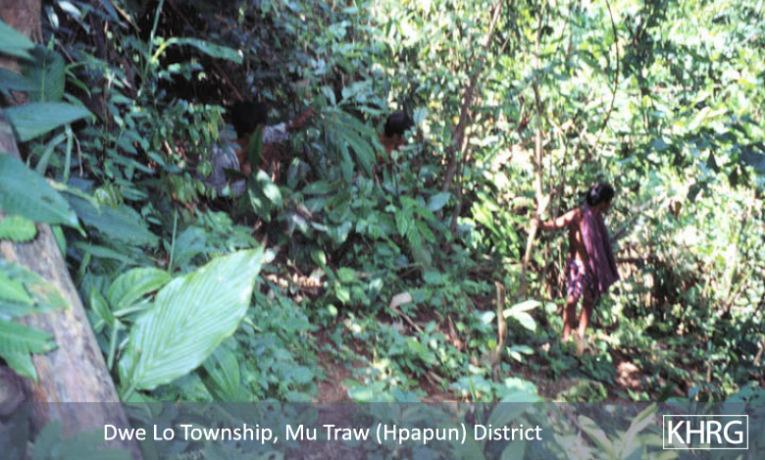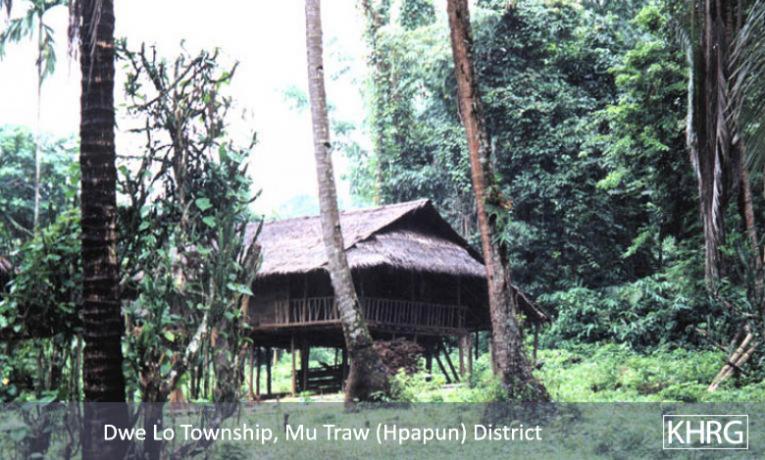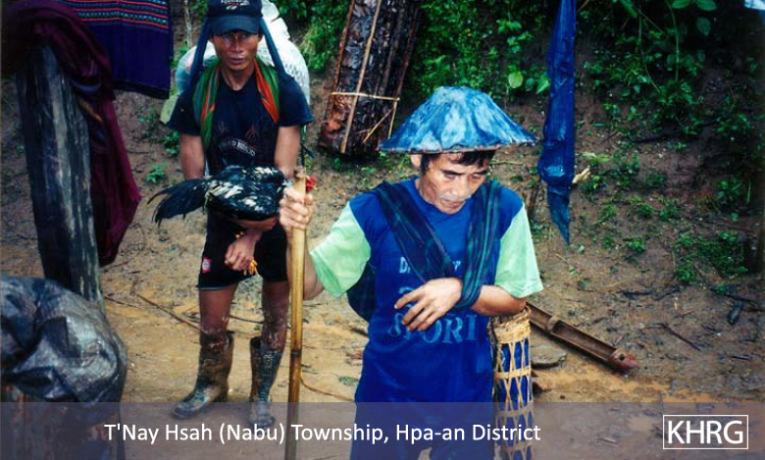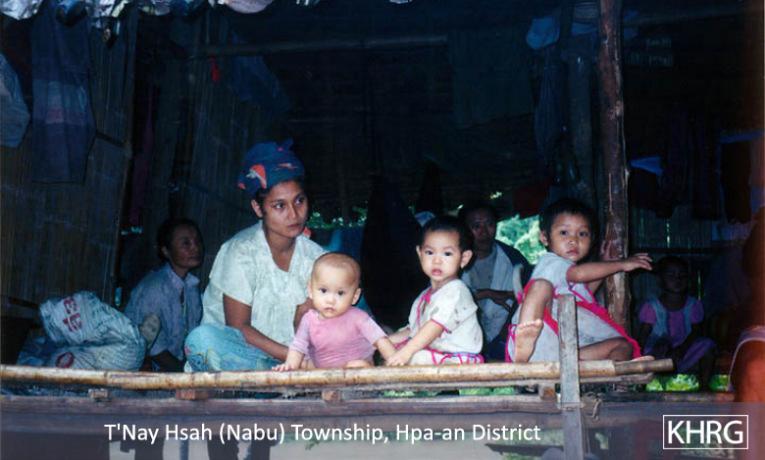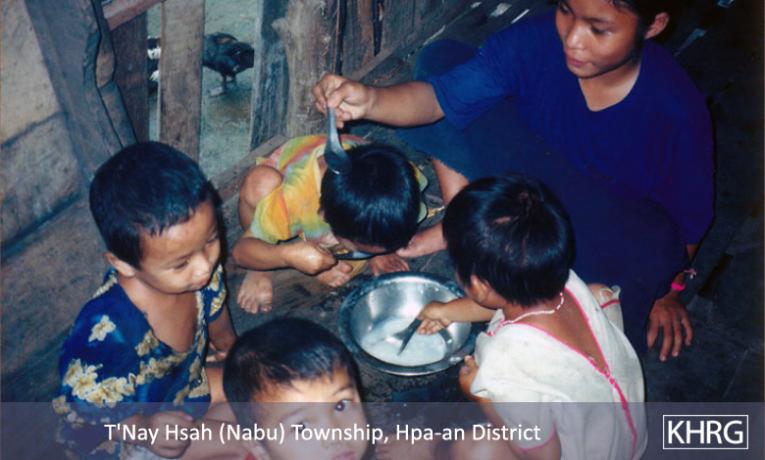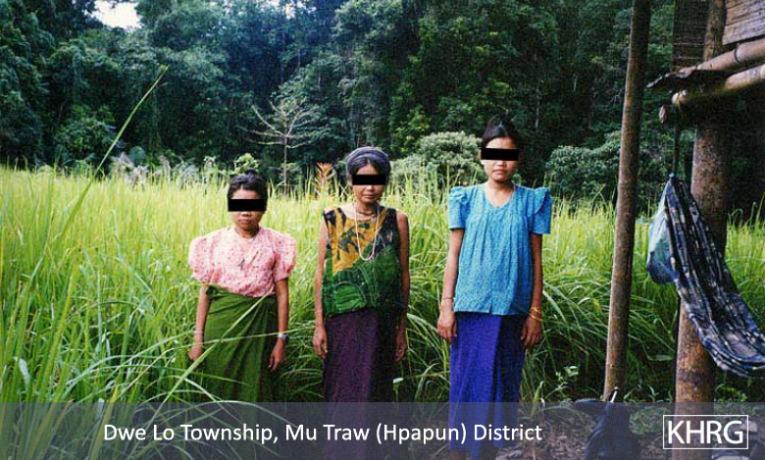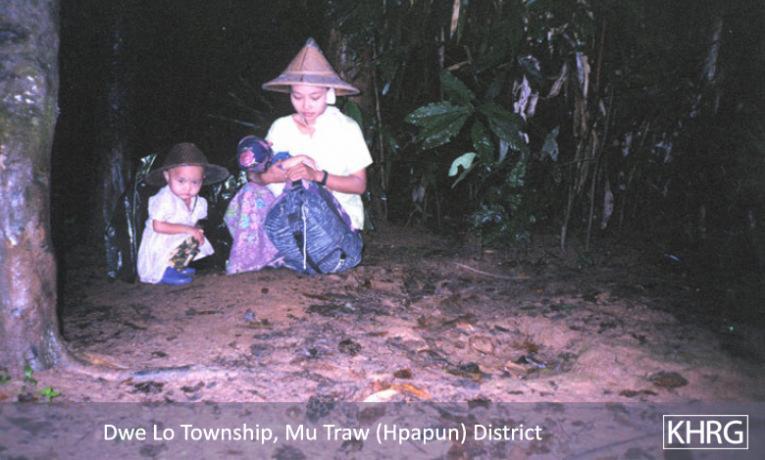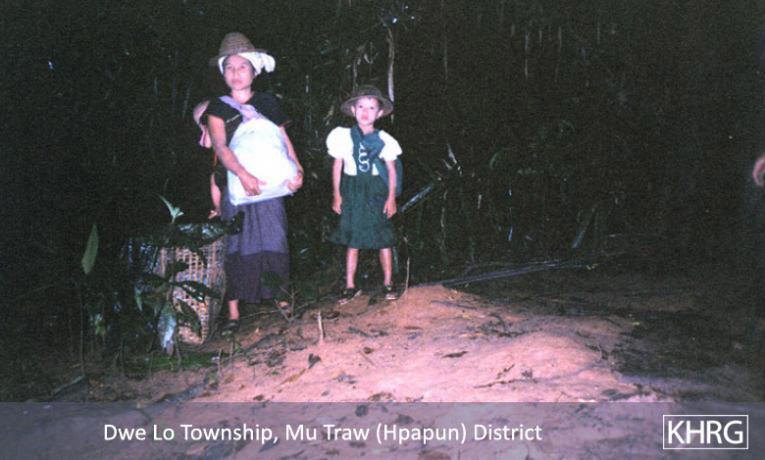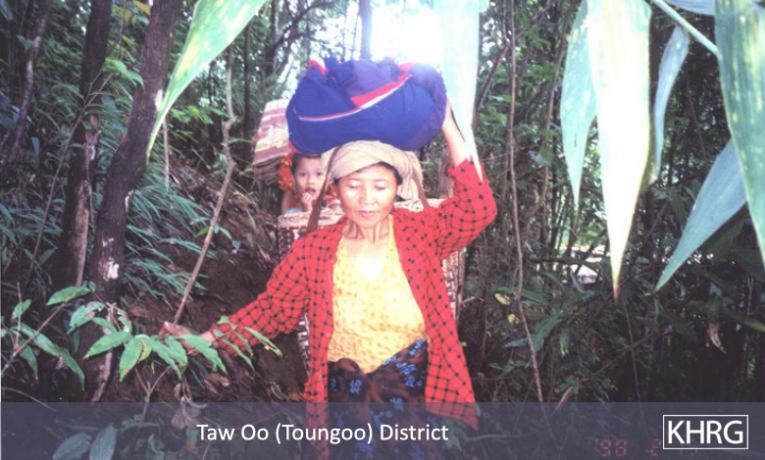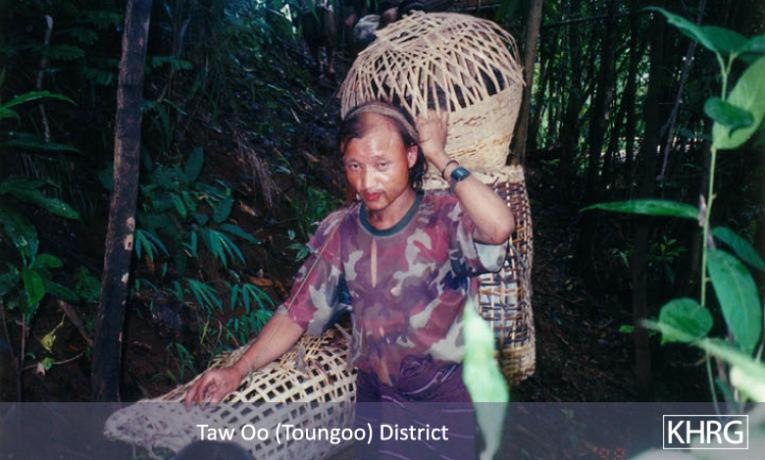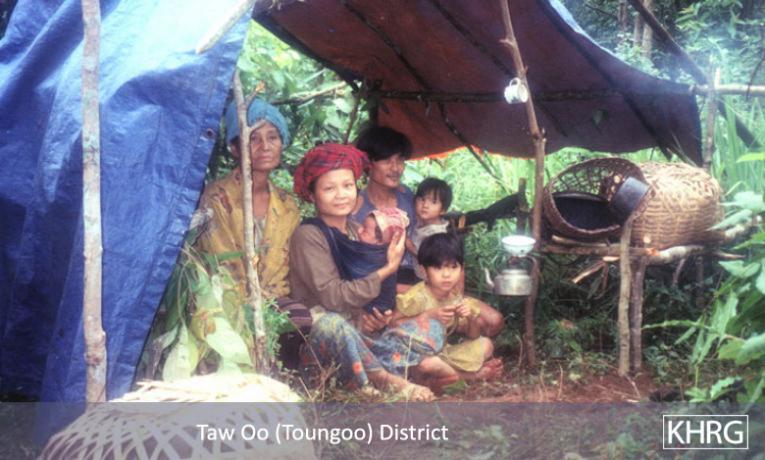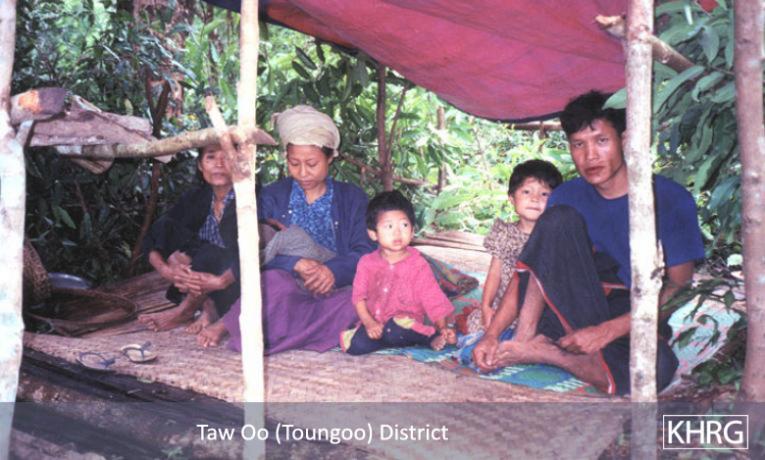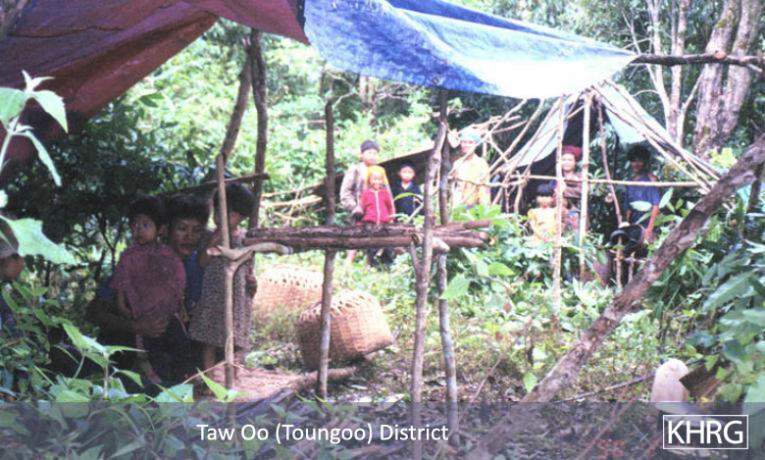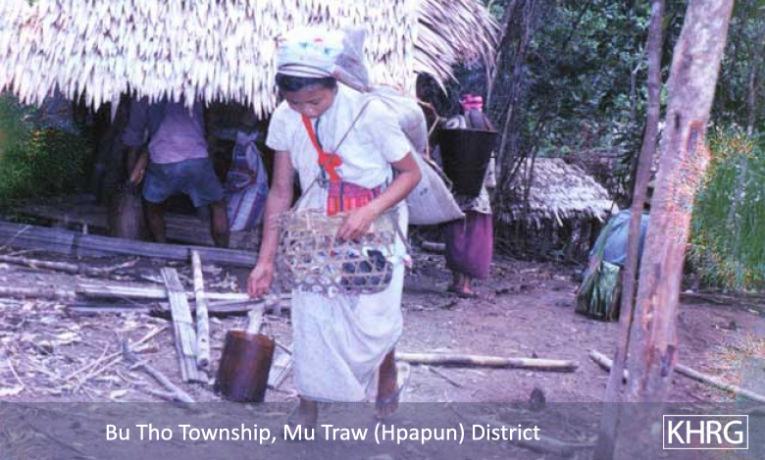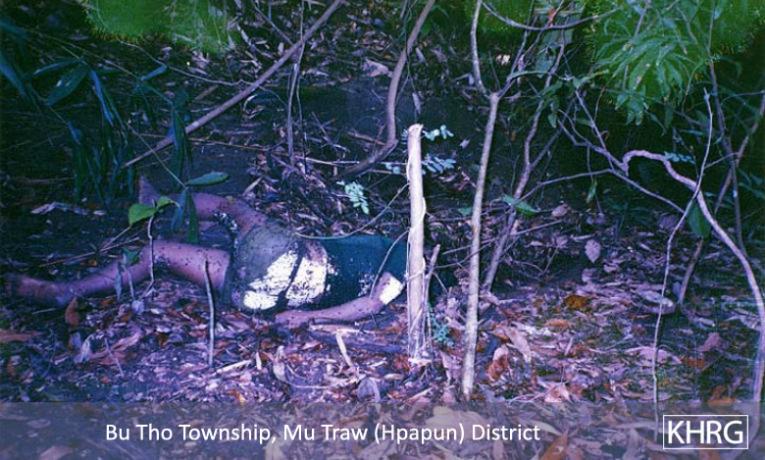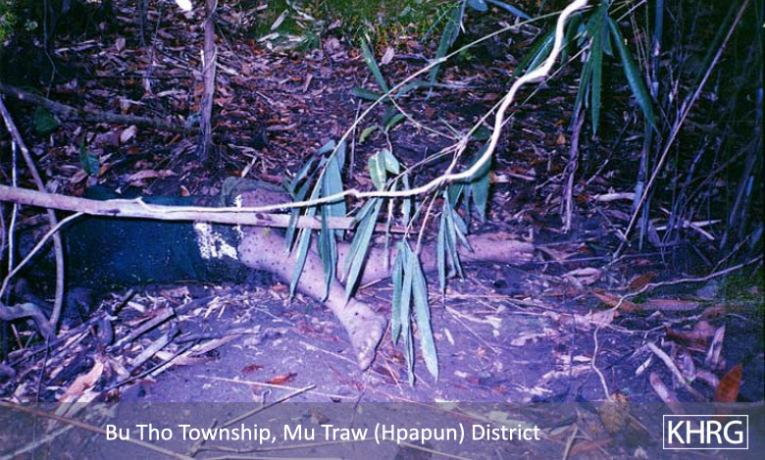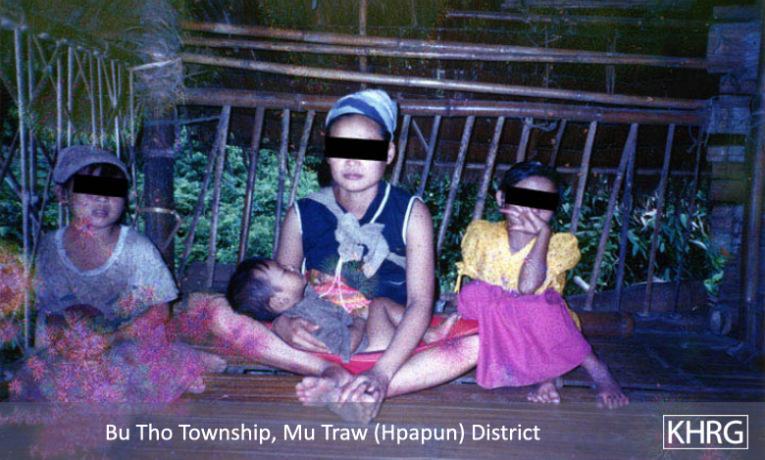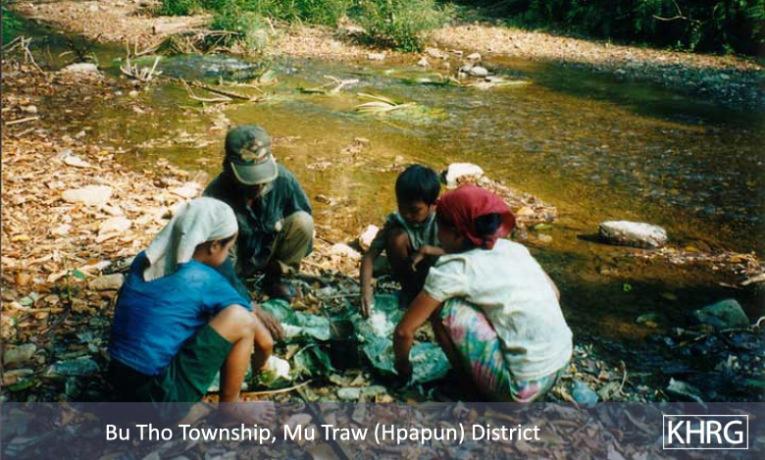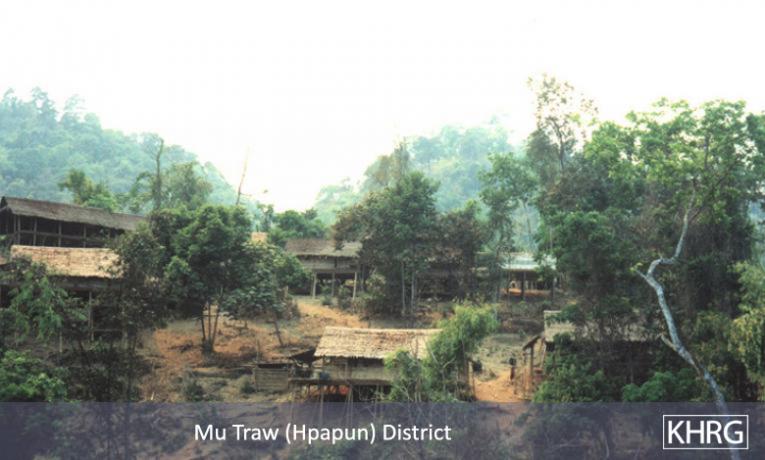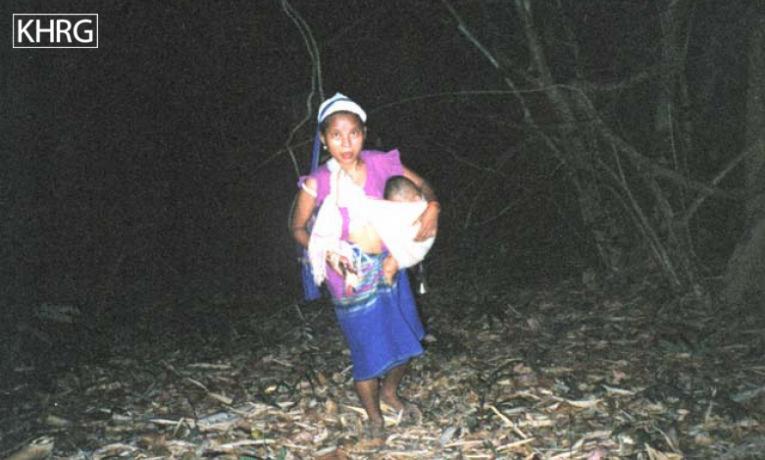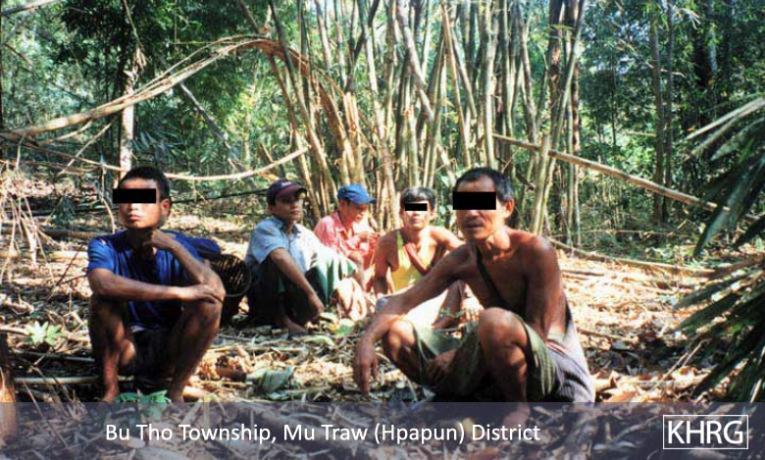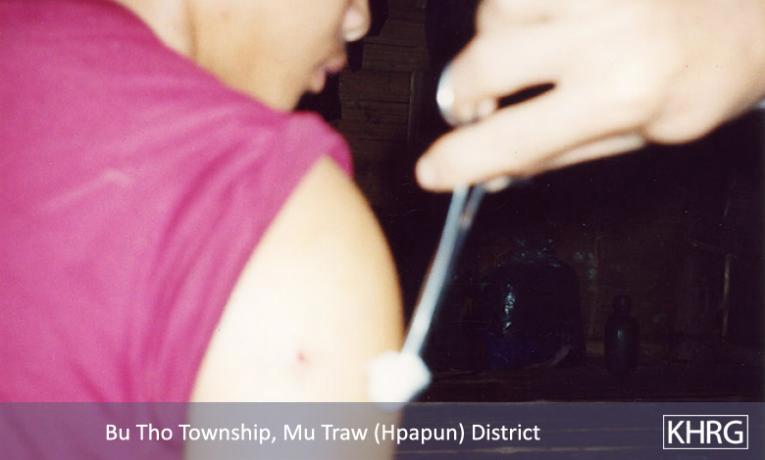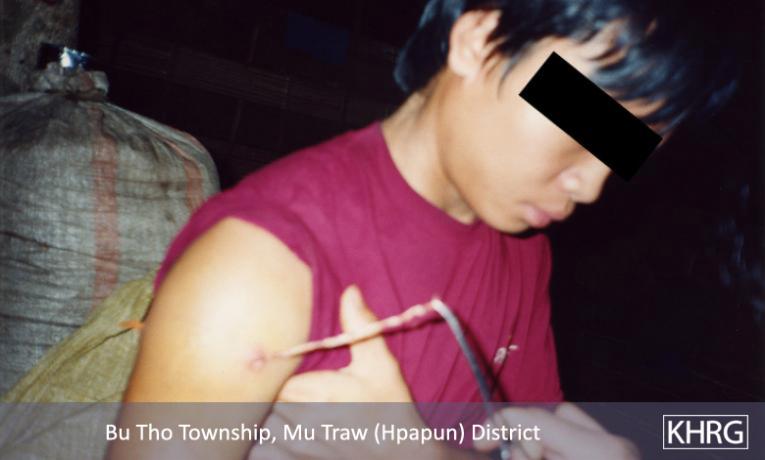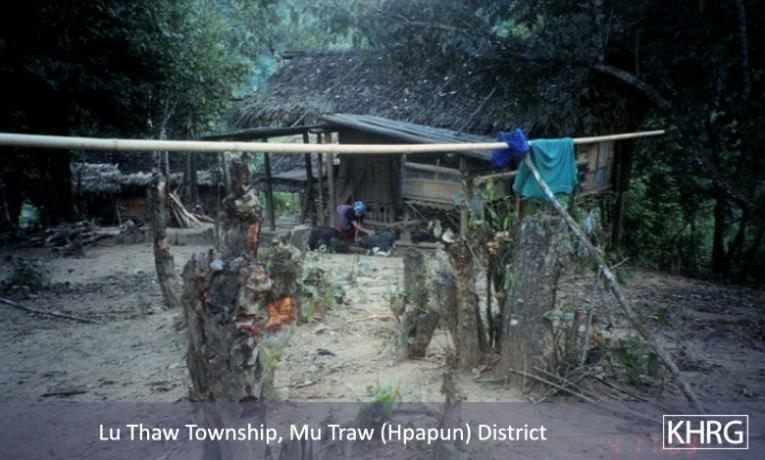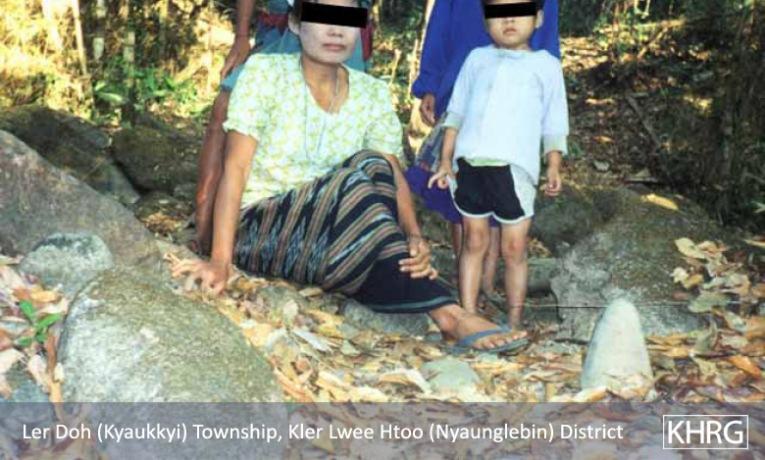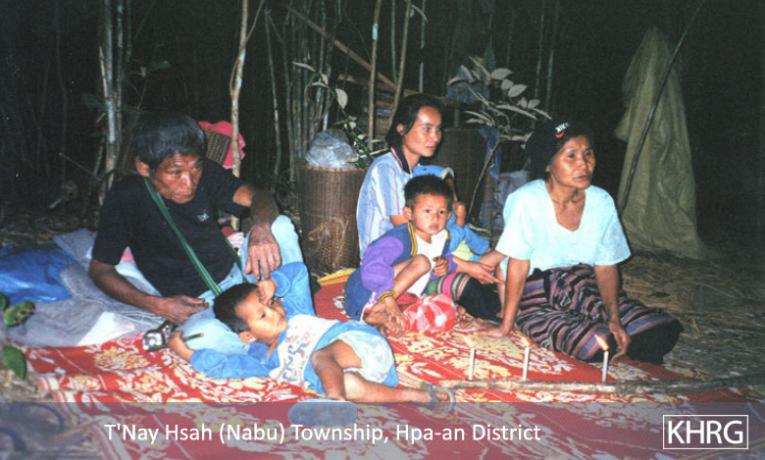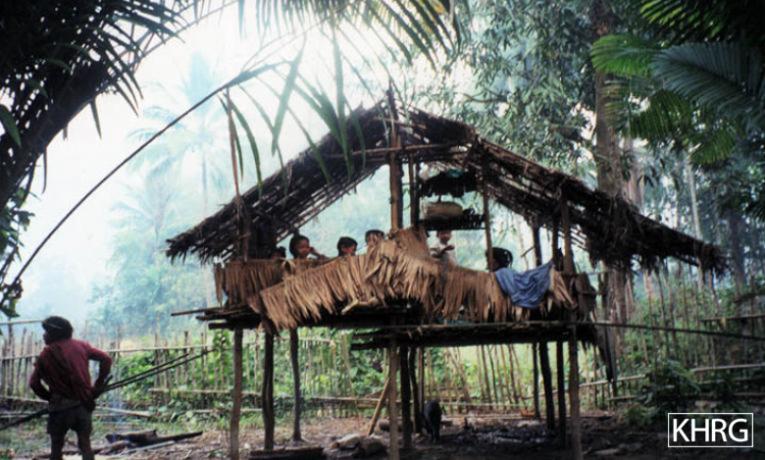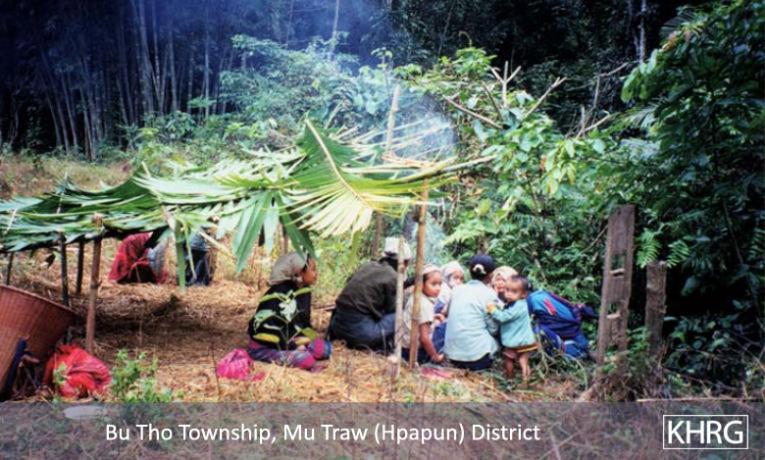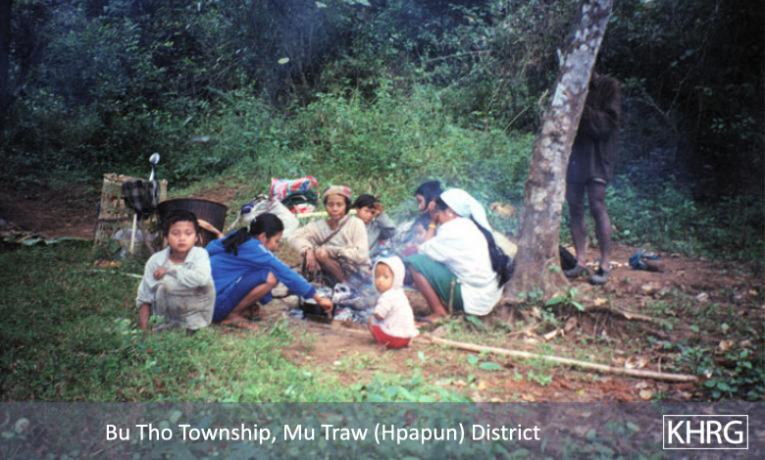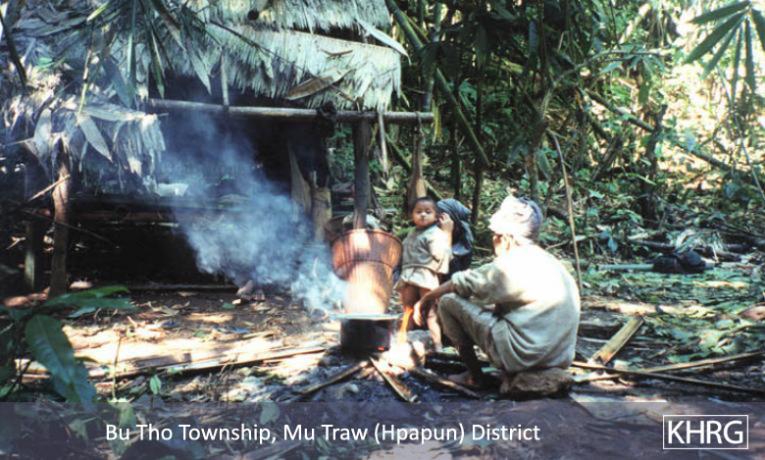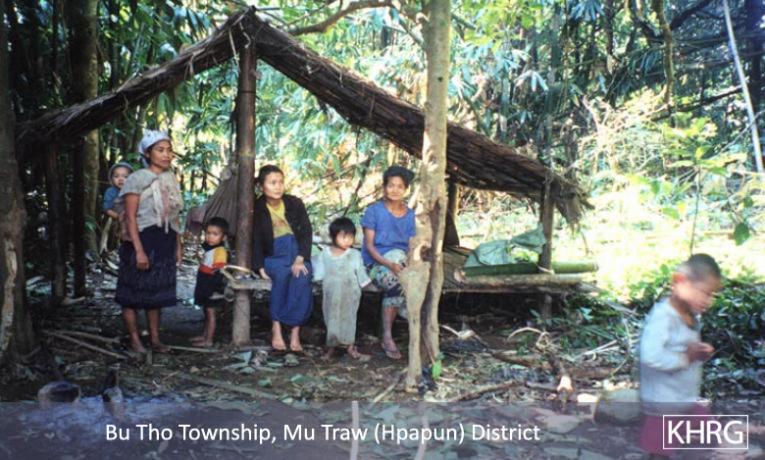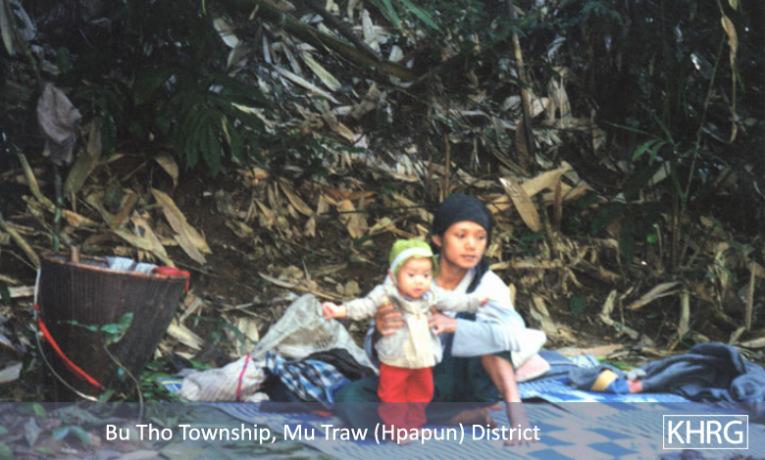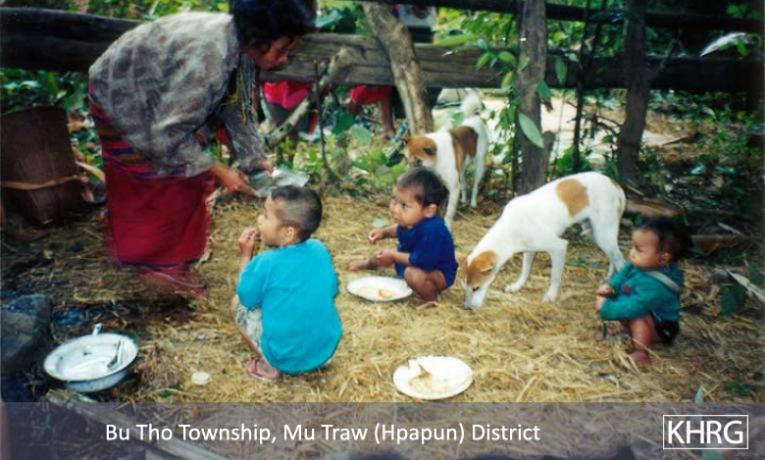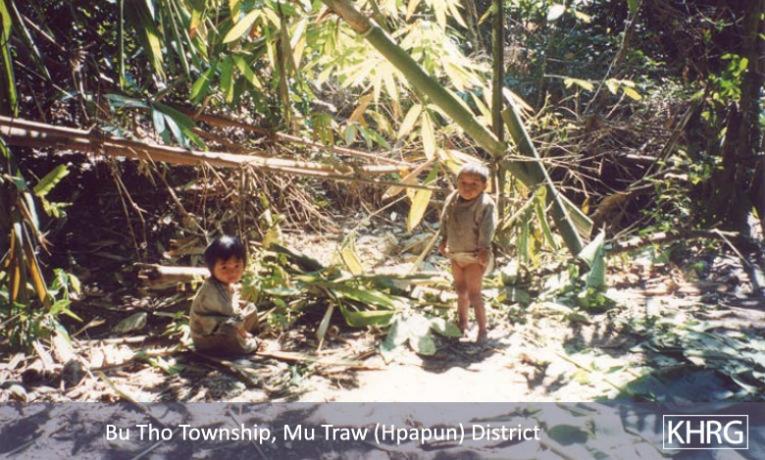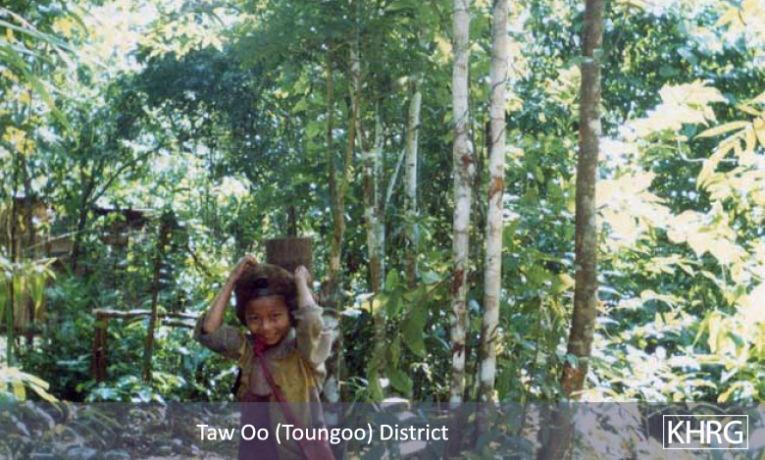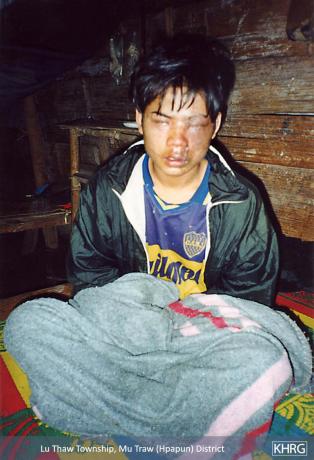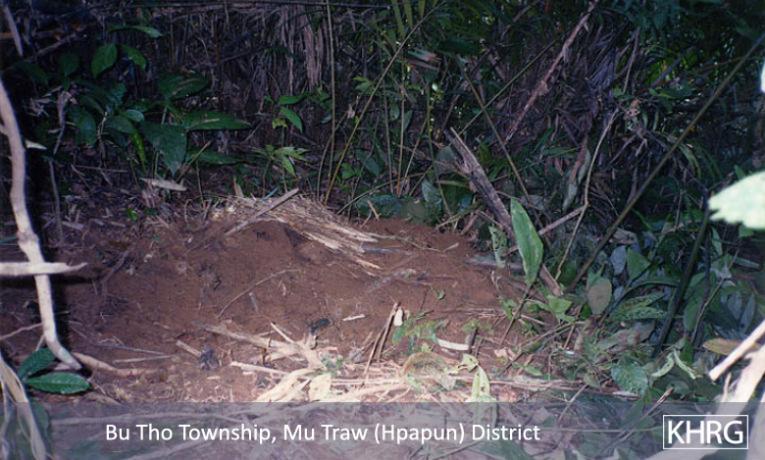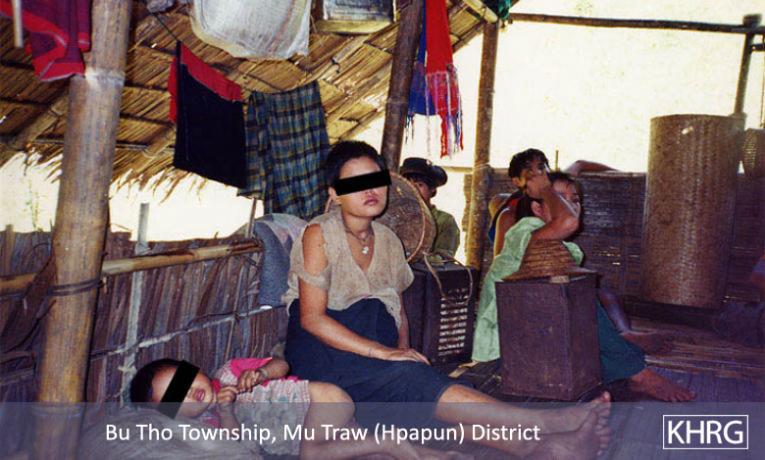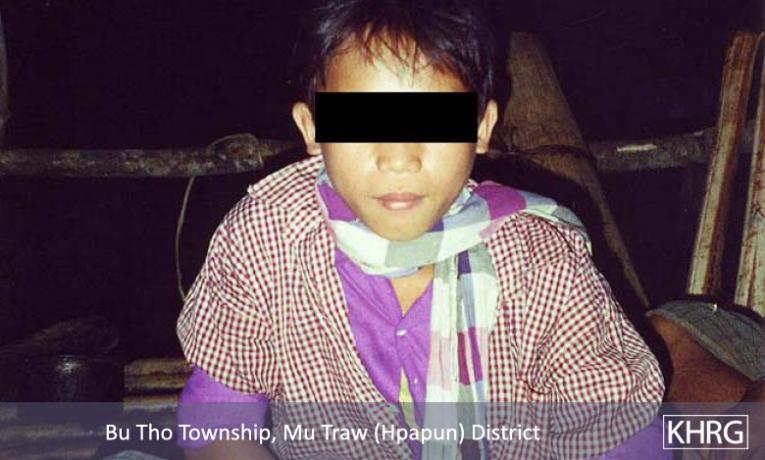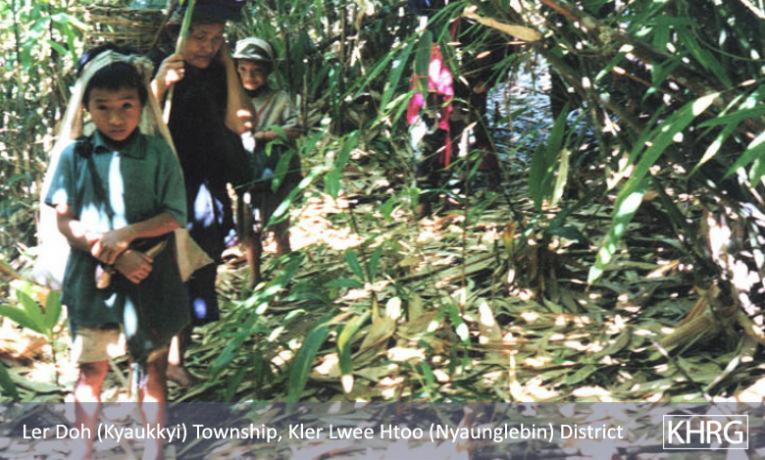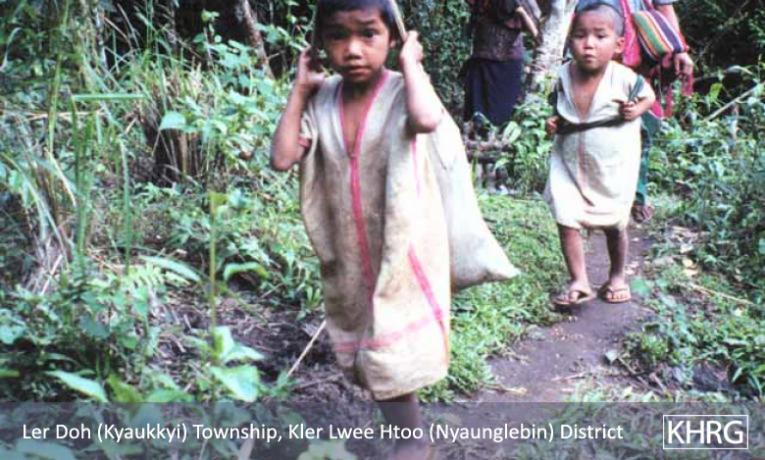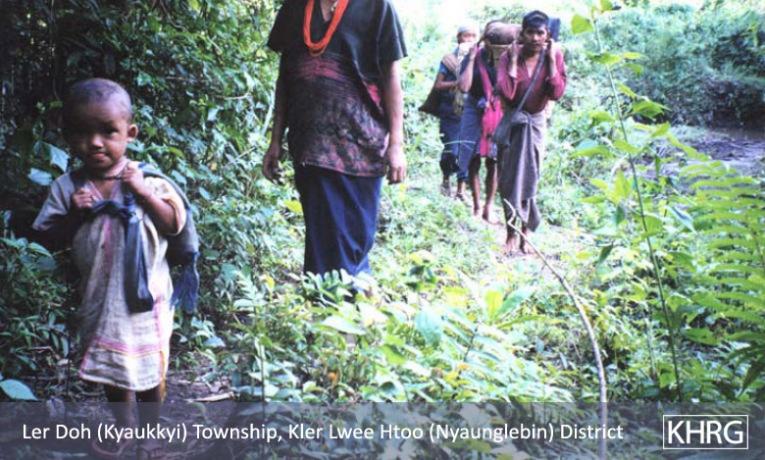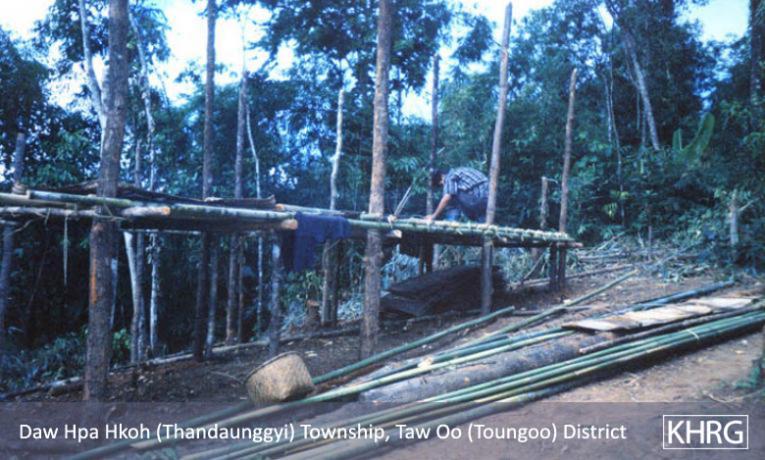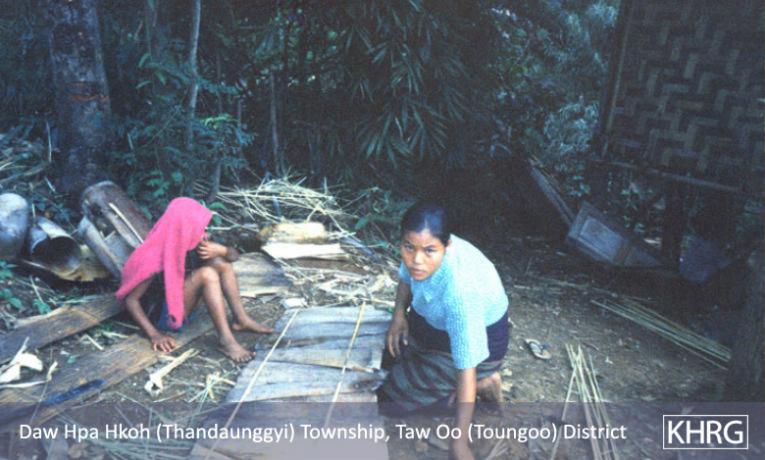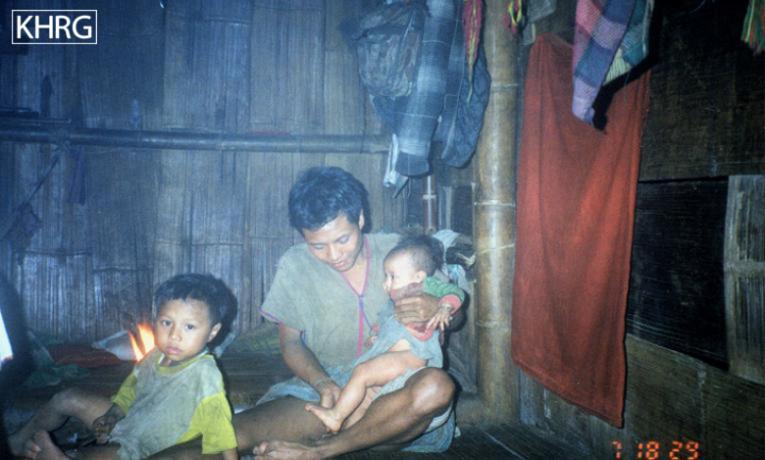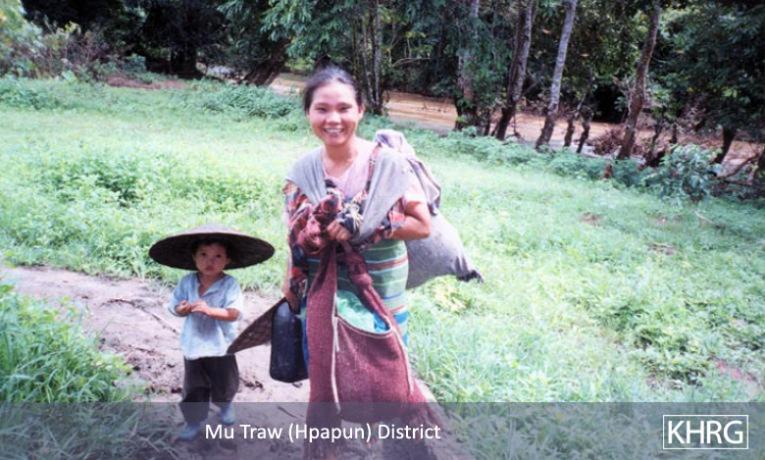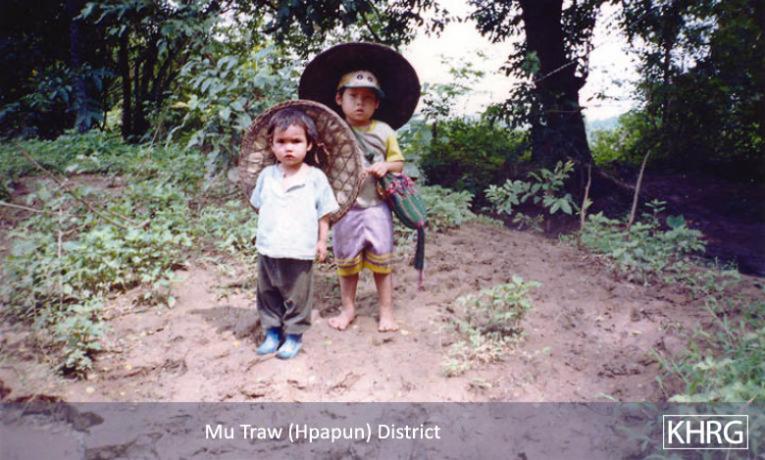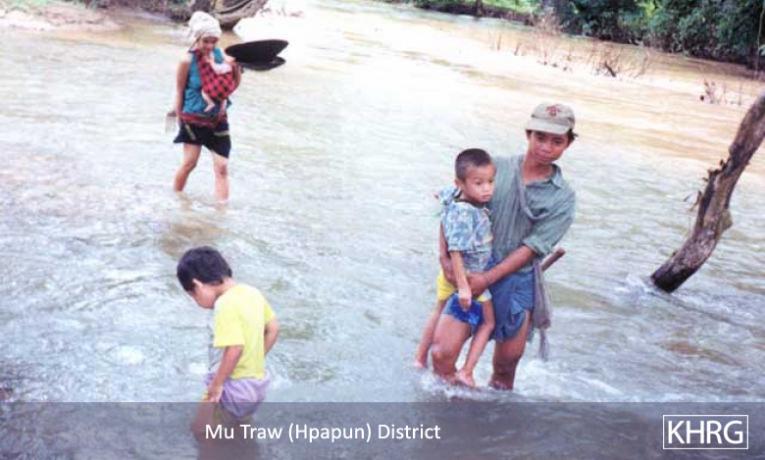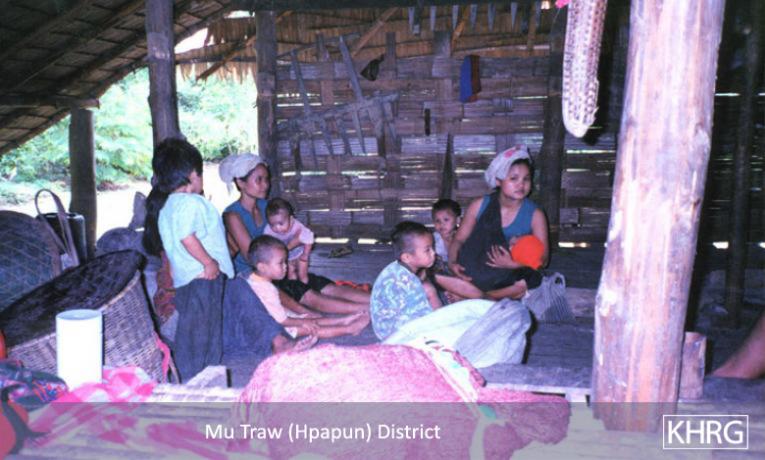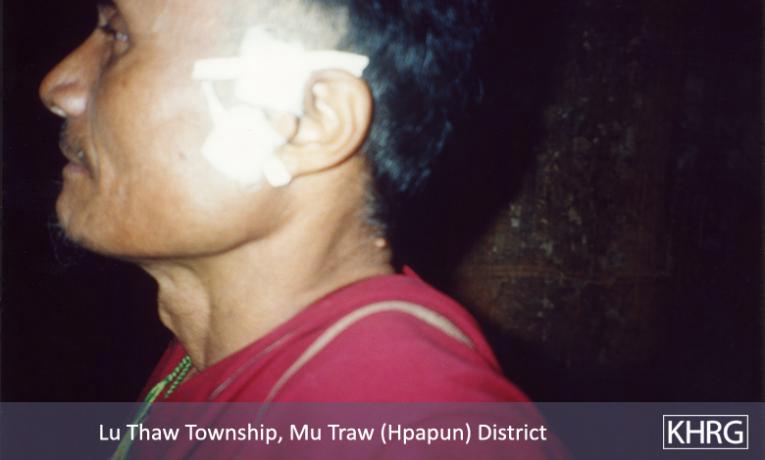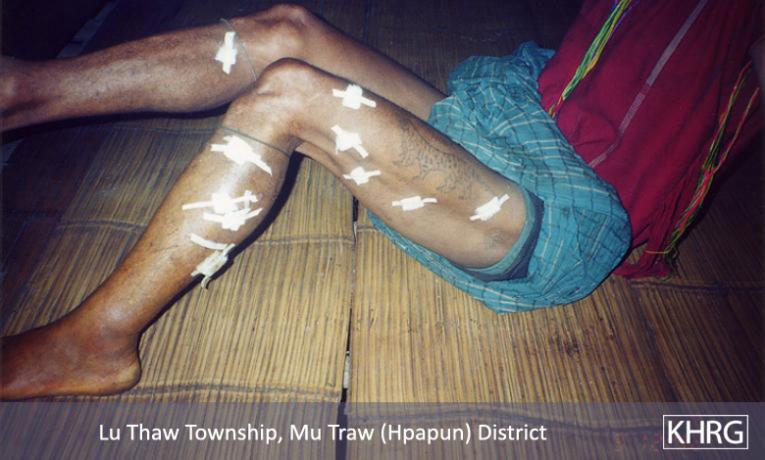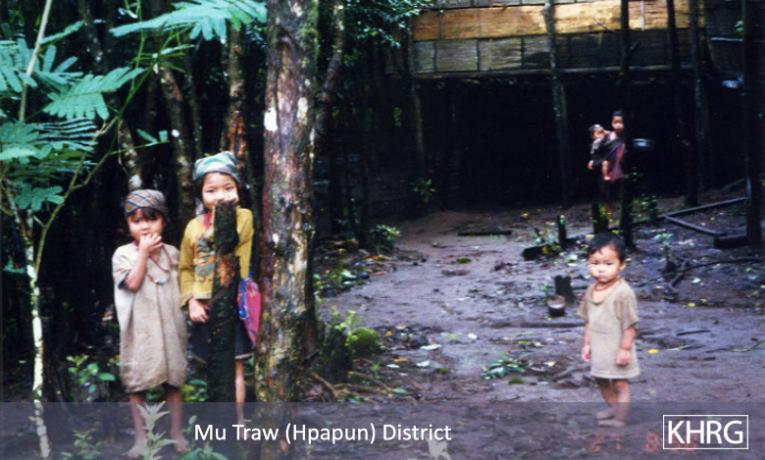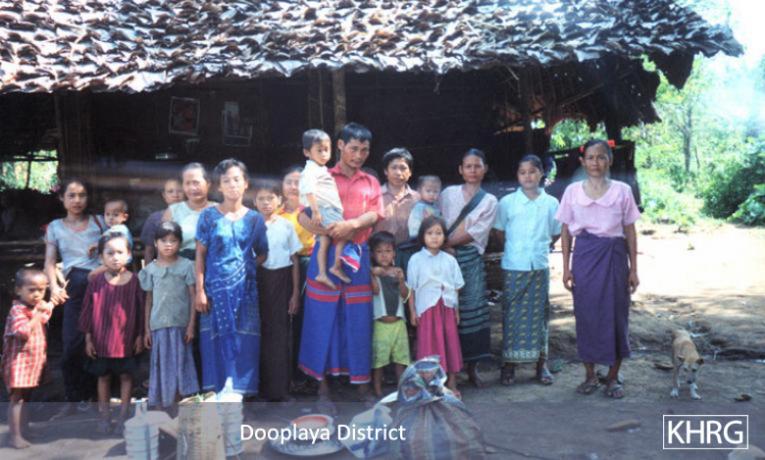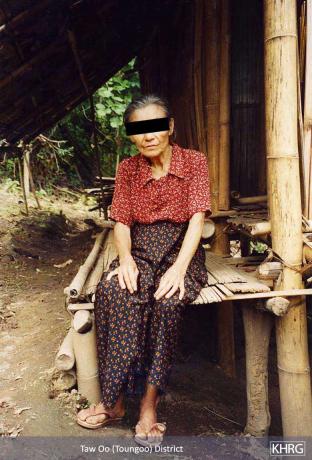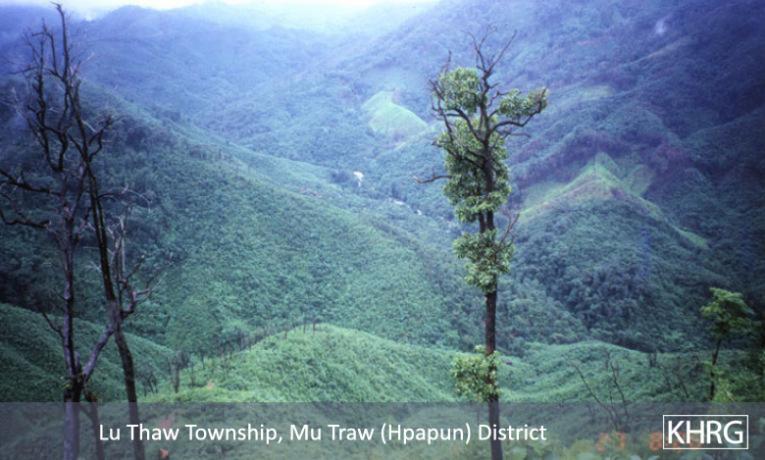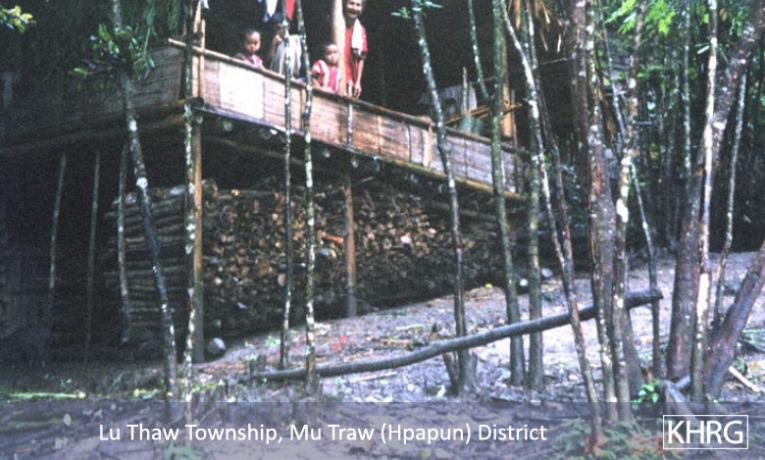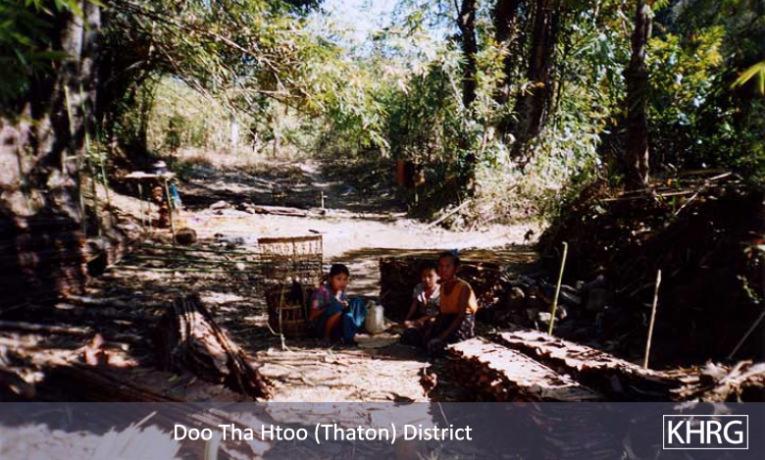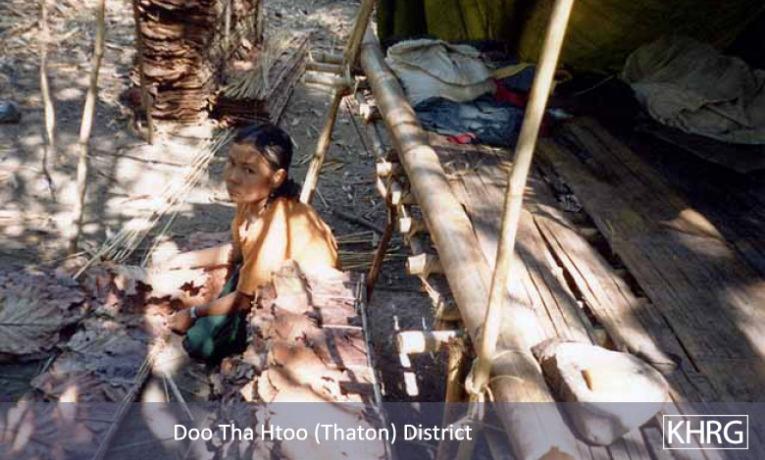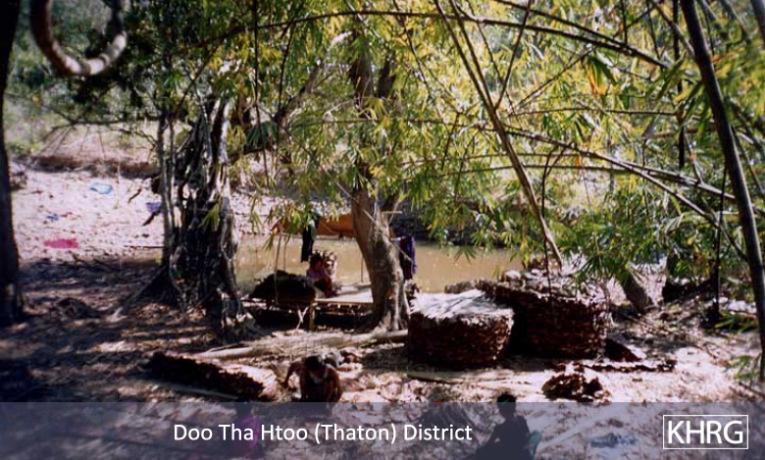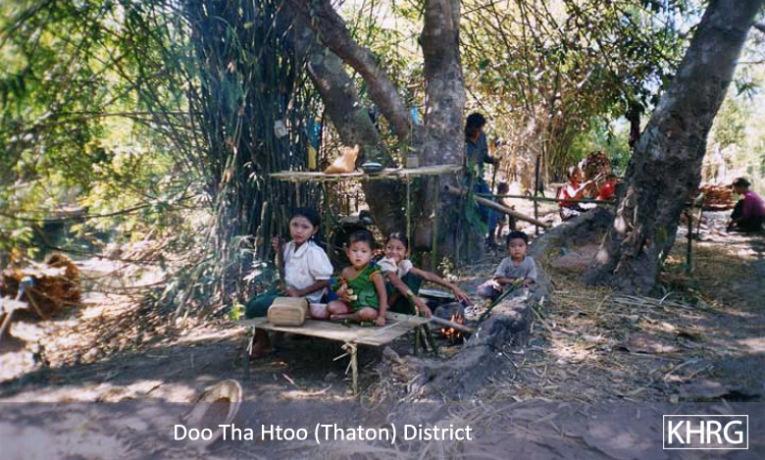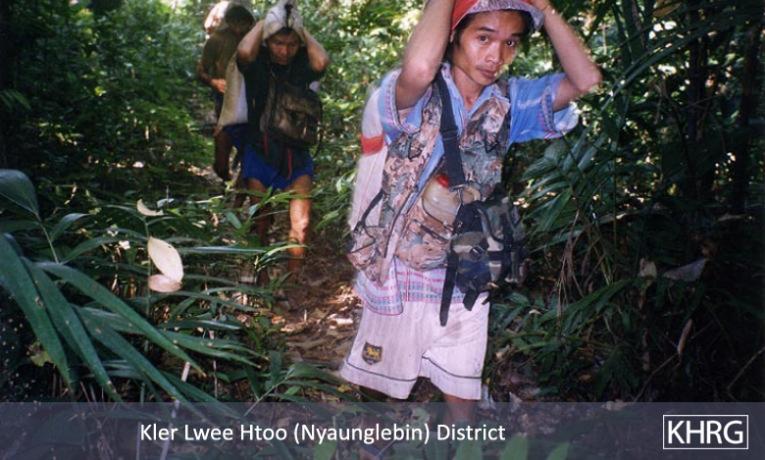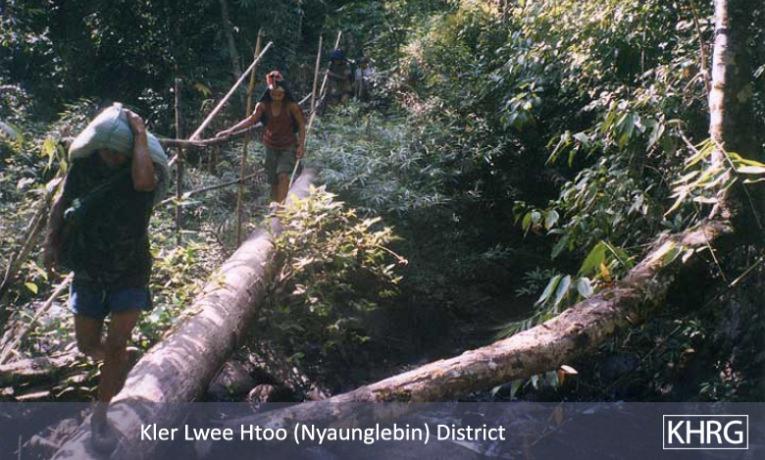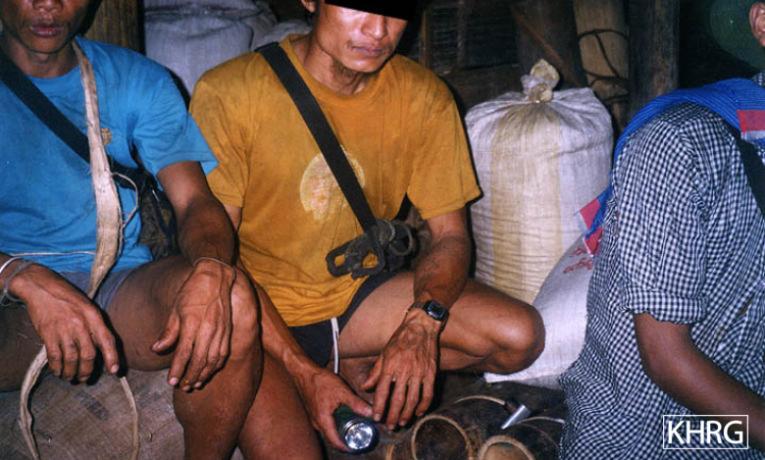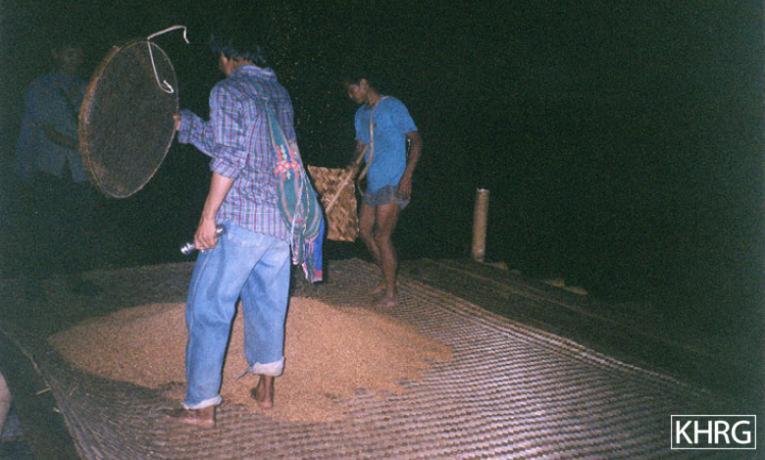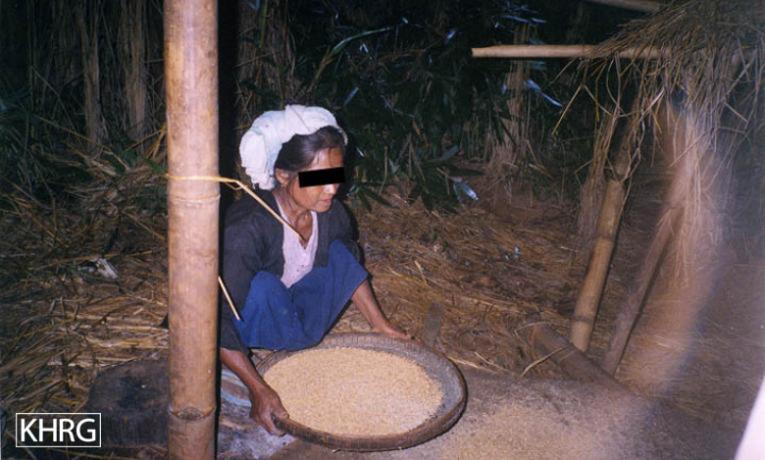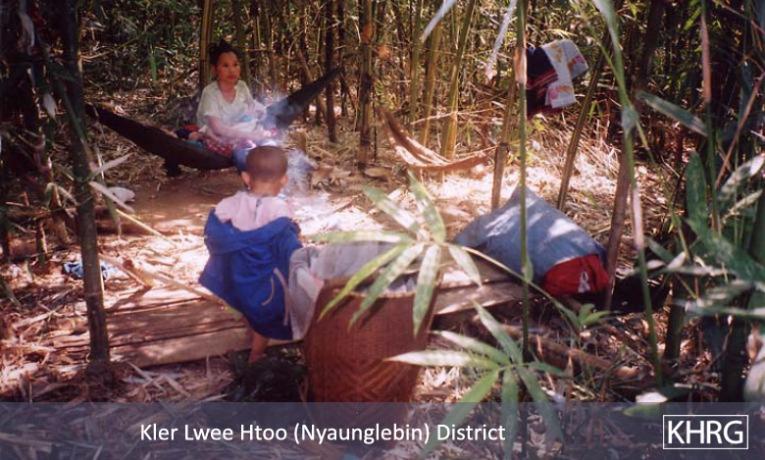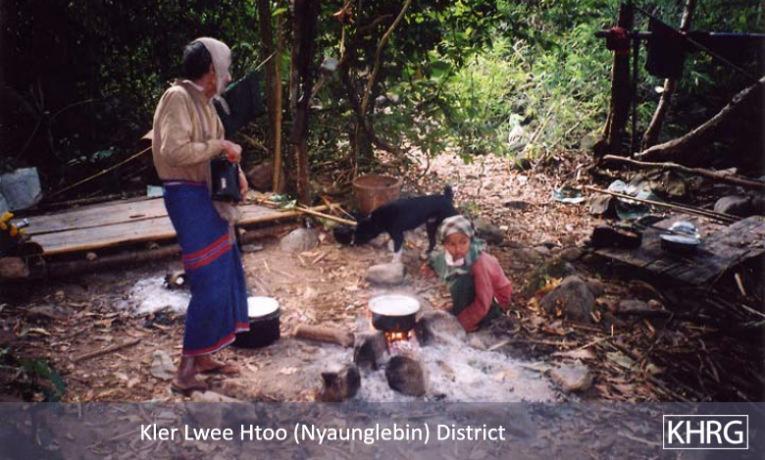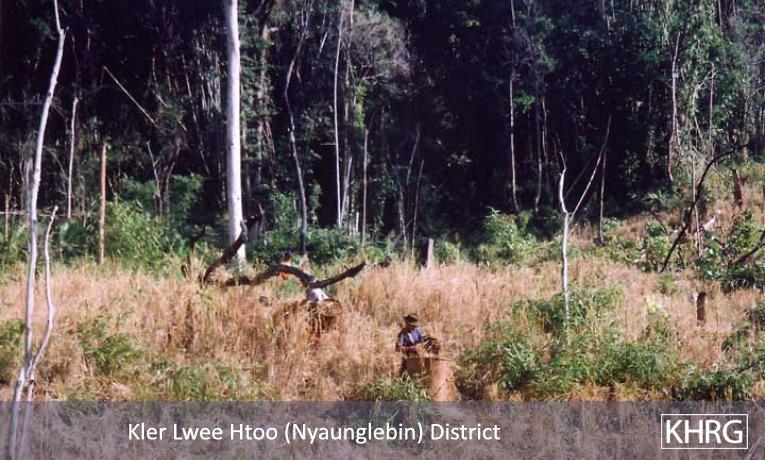Flight and displacement takes on many different forms in rural Karen areas. In SPDC-controlled villages, people find they can no longer survive adequately due to the demands for forced labour, the extortion, and the regime of restrictions they face in their daily lives, and leave their village for areas where the SPDC has less control. People in remoter areas are issued forced relocation orders and either move to the relocation site as ordered, or move into hiding near their village. Hill villagers find they can no longer farm because a new road lined with SPDC Army camps is pouring SPDC troops into their area, so they move into the higher hills. People already living in hiding in the forests have to flee to remoter areas when SPDC columns come too close. Villagers in forced relocation sites, cut off from access to their land, find they cannot survive and flee back to the area of their home village.
Flight and displacement takes on many different forms in rural Karen areas. In SPDC-controlled villages, people find they can no longer survive adequately due to the demands for forced labour, the extortion, and the regime of restrictions they face in their daily lives, and leave their village for areas where the SPDC has less control. People in remoter areas are issued forced relocation orders and either move to the relocation site as ordered, or move into hiding near their village. Hill villagers find they can no longer farm because a new road lined with SPDC Army camps is pouring SPDC troops into their area, so they move into the higher hills. People already living in hiding in the forests have to flee to remoter areas when SPDC columns come too close. Villagers in forced relocation sites, cut off from access to their land, find they cannot survive and flee back to the area of their home village. These are only a few examples.
When Karen villagers become displaced, they usually do not go far because they want to retain access to their fields and to familiar terrain. Sometimes the initial move is simply to the farmfield hut. People continue trying to plant and harvest, though covertly, and keep their rice supplies hidden in the forest. If SPDC troops become more active in their area, however, they may have to choose between a very mobile life near their fields, or moving further away from the SPDC presence. This forces them to find new land to plant, possibly to switch to a crop less visible than rice, and to diversify their livelihood, usually becoming more dependent on forest foods and cash crops. Obtaining rice becomes a major logistical dilemma. Some find they can no longer manage their survival, or encounter a disaster like the destruction of a crop or the loss of a family member, and must decide whether to continue the struggle or flee the area entirely.
Photos in the other sections of this report document the factors leading villagers in Karen regions to become displaced; the photos in this section illustrate the dynamics of displacement itself. This begins in Section 10.1, Life on the Run , by showing villagers on the move: the preparation for flight, the participation of family members in transporting their food, belongings, and each other, the separation and reunification of families and villages, and the ways villagers establish shelter and survival while keeping one step ahead of the SPDC columns sent to capture or kill them. Section 10.2, Food and Survival , then examines how displaced villagers change and diversify their livelihoods in the struggle to establish food security, and how they can survive for years under conditions which would appear to make survival impossible. Section 10.3, Health , continues by looking at the threats to displaced villagers' health and lives and how they deal with these: the exposure to diseases like malaria and dysentery, the lack of medicines and medical help due to the SPDC blockade against medicines entering the hills, the attempts to save the lives of landmine victims and critically ill villagers, and the sporadic assistance given by KNLA medics and mobile medical teams. Section 10.4, Education , looks at the disruption of education brought about by displacement, but more importantly at the villagers' intense efforts to continue schooling their children even when facing much more urgent threats to survival. What can appear initially as quixotic and misplaced efforts to teach children in the forest turn out to be important strategies to maintain the dignity, continuity, and community solidarity which are essential to long-term survival 'on the run'. Finally, Section 10.5, Flight to Thailand , looks at the factors which can lead people to the difficult decision to abandon their land, and the difficulties they face along the way.
The photos in this section were taken in Toungoo, Nyaunglebin and Papun districts in northern Karen State, Pa'an and Thaton districts in central Karen State, and Dooplaya district in southern Karen State. Most are from the northern districts, where the terrain makes it possible for tens of thousands of villagers to live in hiding and continue evading SPDC control. Some of the photos show villagers from southern Karenni (Kayah State) who have fled to these northern Karen districts to evade SPDC control. In Thaton, Pa'an and Dooplaya districts, SPDC control is more pervasive and there are fewer areas to hide, so villagers sometimes have little choice but moving to a forced relocation site or trying to escape to Thailand. Though numbers are impossible to accurately establish, the number of Karen villagers known to be displaced in the areas shown in these photos is in the hundreds of thousands.
10.1 Life on the Run
The photos below show people in the act of fleeing villages or on the move between IDP hiding sites to keep ahead of SPDC columns and beyond the reach of military control, and some aspects of how they survive this 'life on the run'. Their flight can be triggered by any number of factors. People flee to escape forced relocation orders (see photos 10-28 to 10-29 and 10-32 to 10-34 ); forced labour orders or roundups (photos 10-16 to 10-20 , 6-138 to 6-139 , 10-78 to 10-79 , 6-23 to 6-24 , and 10-107 to 10-113 ); arrest as 'relatives of Karen soldiers' (photos 10-102 , 4-14 , and 10-106 ); after villagers have been arrested, beaten, tortured or killed (photos 10-84 , 8-3 to 8-5 , 10-99 , and 2-20 ); when SPDC columns have come to destroy their villages (photos 1-7 to 1-12 , 10-5 to 10-6 , 10-30 to 10-31 , 10-43 to 10-46 , and 10-116 to 10-117 ); or when the presence of roads and SPDC Army camps has made life in their village no longer viable (photos 10-7 to 10-11 , 10-12 to 10-15 , 10-22 , 10-24 , and 10-88 to 10-93 ). Thousands of people over a large geographic area can be affected in a single SPDC operation, as demonstrated by the forced relocation campaign in southern Karenni (Kayah State) in early 2004, when Karenni villagers fled into northern Karen state and were pursued by SPDC columns, leading to additional displacement of northern Karen villagers (see photos 10-62 to 10-68 ).
As can be seen in many of the photos below, everyone takes part in transporting needed food and belongings when on the move, even small children. Families and neighbours try to stay together, but families often become separated and must look for each other. When SPDC troops came to Naw K---'s village to threaten the villagers, most of the village men were away and the women had to transport everything into hiding, including the children (see photos 10-123 to 10-128 ). With the need for mobility, elderly and disabled villagers often become separated from the rest (see photo 1-4 ), or are left hidden somewhere while the others move on ahead, like the two elderly women in photo 10-61 .
These photos also document some aspects of how villagers survive in these circumstances. For many, their experience of evading SPDC columns extends over the past two decades, so upon leaving their village they are usually very fast to organise and establish shelters, arrange shared food supplies, rudimentary schools and religious worship (see photos 1-7 to 1-12 and 1-13 to 1-16 ). Rather than panic and hunger, organisation and solidarity are the norm. Schools and religious activities are set up as quickly as possible because these provide continuity to village life and focal points for community togetherness while isolated in the forest; and children are still allowed the opportunity to play (see photos 9-9 and 10-15 ). Alternative foods readily available in the forest are prepared, and rice soup is used as a way to make the rice supply last longer (see photo 10-87 ).
In most cases displacement is not a matter of moving a long distance from the village and staying in a new area, but moving to people's farmfield huts or hidden sites near their village, returning to the village occasionally or even living there when SPDC columns aren't around (see photos 10-1 and 6-138 to 6-139 ). People remain constantly ready to move when SPDC columns approach, and return when they leave the area. For most displaced Karen villagers, displacement is not a shift to a different location so much as a shift to a more fluid and mobile lifestyle within their home area (see photos 10-16 to 10-20 and 10-103 ). Photos 10-131 to 10-133 show the type of terrain which surrounds many Karen villages, and the villagers' familiarity with its geography, flora and fauna make this ideal ground for living without being detected. Sometimes IDP hiding sites become well-established and almost like villages themselves (see photo 10-101 ). It is when the SPDC presence becomes constant and pervasive that people are forced to leave the area completely, and this is when things become most difficult because they lose access to their fields and to familiar land and streams.
As long as SPDC forces continue trying to depopulate the area, the villagers are at constant risk of being shot or executed by SPDC columns, especially when they return to their villages and fields (see photos 10-57 to 10-58 , 5-13 , 5-20 to 5-22 , and 5-26 to 5-27 ). Some have been shot at many times over their years of on-and-off displacement (see photo 5-74). Landmines are also a constant threat (see photo 9-14 ). Villagers act to reduce these threats by establishing two-way communication with KNLA units in their area, giving information on events in and around their village in return for information on SPDC movements. This is facilitated by long-standing relationships between village leaders and local KNLA officers, who do not rotate between regions like SPDC officers do, and by the fact that many villagers have relatives in the KNLA. When SPDC columns are in hot pursuit, villagers sometimes call in the KNLA for protection (see photos 10-40 to 10-42 , 10-56 , and 10-57 to 10-58 ). Some KNLA units have even given IDPs homemade landmines to use in protecting their hiding sites, though as photo 11-44 shows this can create more suffering than protection.
For many villagers the cycle of flight, rebuilding, and flight again has been ongoing for most of the past twenty years, since SPDC troops first tried to extend state control into their region. SPDC columns force them to flight, then seek out and destroy their hiding sites (see photos 10-59 to 10-60 ). With time, they may be able to gradually re-establish their village when SPDC officers change (see photo 10-1 ) or when the column focuses on another area, only to have their rebuilt homes burned and destroyed again. Photos 10-115 and 10-119 to 10-121 show villages which have been repeatedly burned over recent years, and the same Karenni villagers who fled to Karen State to escape forced relocation in 2002 (see photo 10-122 ) had to flee to Karen State to avoid forced relocation again in 2004 (see photos 10-62 to 10-68 ). Rank and file SPDC soldiers may sometimes feel remorse for this, as shown by the note scrawled in an abandoned village in photos 10-28 to 10-29 ; but the officer's note shown in photos 10-80 to 10-81 calling on displaced villagers to submit to the SPDC indicates that there is little likelihood that forced displacement will end soon.
10.2 Food and Survival
Rice is the staple food in Karen villages, and after it is harvested and dried it is kept in small storage barns. These were traditionally scattered around the village, but decades of military looting and abuse has changed the tradition and rice barns are now hidden deep in the forest. The SPDC calculates that if villagers can be cut off from their food supply they will have no option but to move into state-controlled areas and submit to the regime. SPDC forces trying to clear people out of areas therefore deliberately target food supplies, taking or destroying whatever rice the villagers have in their village, looting the village of livestock (see photos 7-82 to 7-84 ), seeking out and destroying rice storage barns in the forest (see photos 10-139 , 7-17 , 7-24 to 7-25 , and 7-27 to 7-29 ), and sometimes landmining the ruins of rice barns in case villagers return to see what they can salvage (see photos 11-20 to 11-24 ). Fruit, betelnut and other cash crop plantations are also destroyed (see photo 7-18 ). To prevent the villagers who go into hiding from producing a crop, SPDC battalions hunt out and destroy their hiding sites (see photos 2-31 to 2-36 and 7-35 to 7-36 ), but they actually spend more of their time trying to cut off the villagers' ability to produce food. This is done by sending columns in February and March to find hill fields where the bush has been cut for planting but not yet burned off; by prematurely burning these fields, they prevent a proper burn later and the villagers cannot plant a decent crop (see photos 7-20 to 7-23 ). In September and October columns are sent again, this time to uproot rice which is ripening before the harvest (see photos 7-32 and 7-33 to 7-34 ); sometimes they cannot uproot it all, so they lay landmines before leaving. Harvest time in November to December is usually when the most soldiers come (see photos 1-28 to 1-32 ), because then they can spot groups of villagers in the golden hillside fields from a long distance, making it easy to capture or shoot them (see photos 5-23 to 5-25 , 5-31 to 5-32 , and 5-33 to 5-40 ). Moreover, if villagers have to flee right at harvest time, the crop will go to seed or be taken by insects and animals.
People who move from their home areas to SPDC-controlled areas or forced relocation sites are usually cut off from their home fields, which rapidly degenerate (see photos 7-59 to 7-60 ). Most of them have to find ways to survive by doing paid day labour for farmers or others, supplemented by foraging whatever they can. Combined with the regular forced labour now demanded of them, many find it too difficult to survive and end up fleeing back into their home areas despite the risks.
Those who refuse to relocate become displaced in their home area. Initially they try to harvest the crop currently in the fields and to retrieve whatever rice they have stored around the village (see photos 1-5 to 1-6 , 1-17 to 1-19 , 1-28 to 1-32 , and 1-44 to 1-51 ). Some manage to keep using the rice in their hidden barns, but if these are found by SPDC forces there may be little left that can be salvaged. These sources can only provide food for a limited time. Many people have to abandon their fields because they are too near SPDC camps or roads (see photos 7-39 , 7-49 , and 7-43 ). Roads are extremely dangerous to cross or to move along because of the likelihood of being sighted by SPDC patrols, and this frequently leads to people being cut off from their fields, other family members, and access to medical help (see photos 6-133 and 7-40 to 7-41 ). If SPDC troops operate more than sporadically in the area, the home fields may have to be abandoned (see photos 7-37 and 7-45 to 7-46 ).
Displacement thus forces people to change their ways of farming rice and also to find alternative forms of livelihood. If it is no longer possible to cultivate large hillside fields due to SPDC troop activity, villagers may clear small patches within several fields and divide their crop between these small patches. As rice fields are still exposed, villagers have to work quickly when SPDC columns are not nearby (see photos 1-22 and 7-61 to 7-62 ), sometimes harvesting by night or with KNLA guards. Many begin cultivating small-scale cash crops which can be grown at hidden locations in the forest, like cardamom (see photo 7-44 ). People also increase their reliance on forest foraging, drawing on their knowledge of local forest products (see photo 9-8 ). The villagers in photos 10-134 to 10-138 have switched their livelihood and now produce roofing thatch to sell. To exchange cash crops or money for much-needed rice, people sneak into SPDC-controlled villages to buy rice and carry it back into the forest (see photo 7-63 ). The riskiness of this is illustrated by photos 5-58 to 5-60 , where villagers taking betelnut to market with a KNLA escort were attacked by SPDC troops and shot. An alternative, though also dangerous, is to arrange with traders in SPDC-controlled villages to hold temporary 'jungle markets' where displaced villagers can exchange cash crops and money for rice, dry goods, medicines and other needs (see photos 7-55 to 7-57 ).
The difficulties involved require that every family member become actively involved in food production, which also means that every family member is exposed directly to being shot on sight, stepping on landmines, and other dangers. Some families have already lost family members, which only puts a greater burden on the others (see for example photos 5-31 to 5-32 , and Sections 8.3 [ Women, Livelihoods and Displacement ] and 9.4 [ Orphans ]). Villagers also take measures to make food supplies last longer, such as eating rice porridge instead of steamed rice (see photo 10-141 ), and rely heavily on forest foods they would eat less in the village, like bamboo shoots, banana trees, and various roots. Some of these, like klih roots, are semi-toxic and require a lot of processing and would not generally be eaten in the village, but become foods of last resort in the forest. For those who cannot produce enough, others always share what they can. Karen relief teams also move through these areas with aid to improve food security (see photos 7-85 to 7-87 ), but they are under-resourced and can only reach a minority of IDPs on a regular basis.
10.3 Health
Once they are displaced, villagers are much more exposed to dangers such as illness, landmines, and being shot by SPDC soldiers, yet they have very little access to health care. IDPs generally cannot seek medical help in SPDC-controlled towns and villages, either because there is too much danger of arrest or because the treatment is far too expensive (see photo 8-16 ). If they are in hiding in the hills, medical help from SPDC-controlled areas cannot come to them because the SPDC enforces a blockade against medicines and medical help going into areas they are trying to depopulate. Most displaced villagers therefore only have access to traditional remedies, which often prove insufficient (see photos 8-20 , 8-10 to 8-12 , 10-146 , 8-18 to 8-19 , and 9-25 ), or sometimes to KNLA and Karen relief medics (see text below).
Disease and malnutrition kill more displaced Karen villagers than are killed by SPDC troops. Once displaced it is difficult to obtain a stable supply of food good enough to avoid malnutrition, and if people are in a forced relocation site or far from their village they are forced to rely on unknown and often unclean water supplies. Displaced villagers are exposed to malaria, dysentery, typhoid, tuberculosis, dengue fever, encephalitis and a host of other illnesses, infections and parasites, and often also fall prey to oedema, goitre, and other conditions brought on by dietary deficiencies. Frequently forced to sleep in the open, they are very vulnerable to mosquito-borne illnesses like malaria, dengue and encephalitis. Children (see photos 10-3 to 10-4 ), the elderly, and pregnant and nursing women (see photos 8-10 to 8-12 ) are the hardest hit groups. Many women fall ill because they are weakened by the multiple burdens of producing and foraging for food, caring for children, and being on the move, increasing their vulnerability to all of the threats already mentioned (see photos 8-8 and 8-9 ). Many mothers give birth in the forest in unsanitary conditions and with little or no help (see photos 8-15 , 8-17 , and 8-24 to 8-25 ). Maternal and child mortality and morbidity are both extremely high (see photos 8-13 and 8-18 to 8-19 ).
There is also the constant danger of being shot by SPDC columns (see Section 5, Shootings and Killings ) or stepping on landmines (see photos 11-11 and 11-12 to 11-15 , and other photos in Section 11 [Landmines] ). Landmines are laid by all armed forces in these areas and are seldom removed. KNLA forces are the only ones to try to inform the villagers of which pathways are mined, but the information they provide is insufficient and many villagers still detonate their mines. Villagers who survive shootings or stepping on mines carry the resulting disabilities for their entire lives, particularly because proper treatment is unavailable (see photos 11-48 to 11-49 and 5-77 ); while more still suffer the effects of previous forced labour (see photo 10-147 ) and other SPDC abuses.
Apart from traditional remedies, the only treatment available to most Karen IDPs comes from KNLA medics or mobile medical teams sent by local relief organisations (see photos 10-143 , 10-144 to 10-145 , 8-8 , 9-23 , 8-9 , 9-24 , 10-149 to 10-150 , and 10-151 to 10-153 ). These medics cannot always reach IDPs in all areas (see photos 8-14 and 11-48 to 11-49 ) and their presence is sporadic, so people with serious wounds such as landmine victims must usually be carried for several days to reach a medic, dodging SPDC columns and landmines all the way (see photos 11-16 to 11-18 and 11-47 ). Even if they can be reached before the patient dies, these medics are often short of medicines and dressings. Photos 11-16 to 11-18 , for example, show an amputation being performed without anaesthetic on a Karenni landmine victim, who had already been carried several days from southern Karenni (Kayah State) to northern Karen State to reach medical help.
10.4 Education
Education is highly valued in Karen communities, not for material reasons but as a way of preserving culture and language, reinforcing identity, and strengthening dignity and community solidarity. Despite the fact that completing school in a Karen village brings few or no career or material advantages, people put a lot of effort and resources into village schools and see them as a focal point of community life (see photos 10-157 to 158 and 9-30 ). When communities become displaced, schooling is not abandoned to make way for more immediate survival needs; instead, it is treated as more important than ever, and efforts are made to immediately establish rudimentary schools even while people are still living on the bare ground of the forest under banana leaves (see photos 10-154 to 10-156 , 1-52 to 1-55 , 10-7 to 10-11 , and 9-26 ).
Displaced villagers in hiding are usually widely scattered in groups of a few families, so they sometimes arrange to set up a single school somewhere and send their children there (see photos 9-35 and 10-160 to 10-161 ). Most of these schools are at primary level, because the local teachers available have no more than primary education themselves (see photo 9-37 ). They have only whatever notebooks, pencils and chalk the parents can afford to buy (see photos 9-29 , 9-30 , and 9-33 ). Students wanting to continue to middle and high school must either travel to one of the few KNU higher-level schools located in areas where there is little SPDC activity (see photos 9-27 to 9-28 ), or go to a refugee camp in Thailand. Some parents send their children to refugee camps for the school season, while remaining in hiding themselves near their home village; the students then return to help their parents during the March to May school holidays. Some children, however, are needed constantly to help their families produce enough food to survive and cannot attend even primary school (see photo 9-34 ), or have to quit before finishing because of some disaster like the loss of a family member (see Section 9.4 [Orphans] ).
Recognising the importance of village schools to Karen identity and village solidarity, the SPDC tries to destroy them and refuses to allow any schooling to exist outside the state-controlled system. Non-state schools are burned if found (see photos 1-52 to 1-55 ), whether in villages or in IDP hiding sites. Whenever SPDC columns are nearby the villagers have to close their schools, so some of them can only remain open sporadically (see photos 9-27 to 9-28 , 9-29 , 9-31 , 9-32 , 9-36 , and 9-38 ). Yet despite the risks, villagers have stated to KHRG that education will remain a priority for them if only to prevent the SPDC from succeeding in its attempt to dehumanise them and destroy their communities.
10.5 Flight to Thailand
Most Karen villagers feel a very strong bond to their village and their land, and would suffer almost any deprivation rather than leave it. Sometimes, however, they can be pushed into a state where they no longer think they can survive. This can be caused by the construction of an SPDC camp too near their fields, the sudden destruction of their entire food supply, the loss of family members due to disease or violence, or other disasters, which sometimes operate in combination or with cumulative effect. For some people this occurs while they are still in their village (see photos 10-174 to 10-181 ), for others while they are evading SPDC forces by living in the forest (see photo 10-173 ); it can be sudden (see photo 3-3 ), or a gradual accumulation of suffering over years (see photos 10-162 to 10-163 ). When this point is reached, most people opt to flee across the border rather than submit to SPDC control, forced labour and impoverishment by moving into state-controlled areas. When possible, their flight is temporary (see photos 10-164 to 10-169 and 10-170 to 10-172 ), but if SPDC forces establish a consistent presence in their home area they may not be able to return.
Fleeing to Thailand is difficult and dangerous. In most areas, the terrain is mountainous and polluted with landmines, the villages along the way may have already been destroyed eliminating the possibility of any help, and fleeing villagers caught by SPDC columns are treated as active rebels (see photos 5-67 to 5-72 ). Once the border is crossed, the refugees must find their way to one of the few remaining refugee camps undetected, because if they are caught by Thai soldiers, paramilitaries, police or forestry officials en route they are summarily and forcibly repatriated (see photos 10-162 to 10-163 ). Finally, those who reach refugee camps often have to hide from Thai camp guards and become 'unregistered' refugees during periods when the Thai government has declared that no new refugees are to be allowed – which is usually when it is seeking to improve ties and trade with the SPDC. Though international NGOs provide food and medical care in the refugee camps, the camps are overcrowded, food is strictly limited by order of the Thai government, and growing food, working outside the camp, and foraging are restricted or prohibited, as part of a Thai policy to encourage refugees to repatriate by making life in the camps unattractive. The camps are also situated in areas vulnerable to cross-border attack by SPDC forces, and some are in areas prone to floods and landslides which periodically kill some of the refugees (see photos 10-182 to 10-194 ). Life for Karen refugees should therefore not be seen as safe, secure, or happy. The vast majority of them would certainly prefer to return home, but their decision not to do so despite all the pressure applied by Thai authorities and UNHCR only demonstrates the difficulty of the situation they have fled.

